WEST SIDE COMPREHENSIVE NEIGHBORHOOD PLAN
LOVEYOUR NEIGHBOR +
LOVEYOUR NEIGHBORHOOD
THE WEST SIDE CELEBRATING A DIVERSE, HEALTHY, AND VIBRANT COMMUNITY



INTERFAITH NEIGHBORS
ASBURY PARK, NEW JERSEY
APRIL 2019

WEST SIDE COMPREHENSIVE NEIGHBORHOOD PLAN
LOVEYOUR NEIGHBOR +
LOVEYOUR NEIGHBORHOOD
THE WEST SIDE CELEBRATING A DIVERSE, HEALTHY, AND VIBRANT COMMUNITY



INTERFAITH NEIGHBORS
ASBURY PARK, NEW JERSEY
APRIL 2019
The Asbury Park West Side Comprehensive Neighborhood Plan was funded by a Neighborhood Planning Grant from the Wells Fargo Regional Foundation (WFRF). The planning process was led by Interfaith Neighbors with guidance from their consultant WRT and a Steering Committee comprised of neighborhood-based stakeholders.
Melissa Halk, After School Program Manager, Our Lady of Mount Carmel School
Dianna Harris, President, Mid-Town Urban Renaissance Corp (MURC)
Connie Isbell, Membership & Community Engagement Director, Monmouth Arts Council
Youth Voice Committee
Anica Cummings
Nashim Fracier
THANK YOU TO THE FOLLOWING PEOPLE:
Interfaith Neighbors
Paul McEvily, Executive Director
Diane Shelton, Community Outreach Specialist
Patrick Durkin, Director of Real Estate Development
West Side Neighborhood Plan Steering Committee
Olga Edwards, Asbury Park Resident & Entrepreneur
Meg Flores, Interfaith Neighbors Youth Specialist
Pamela Major, Asbury Park Resident
Caelin McCallum, Monmouth U MSW Intern/Coastal Habitat for Humanity
Isaac Jones, Entrepreneur/Neighborhood Business Owner, New Barber Life
Beatrice Oesterheld, Executive Director, Community Affairs & Resource Center
Heather Schulze, Executive Director, Coastal Habitat for Humanity
Felicia Simmons, Proper Foundation; Former Member, Asbury Park Board of Education
Nina Summerlin, President, West Side Citizens United
Trudy Syphax, Asbury Park Resident; Member, Asbury Park Planning Board
Henny Valcin, Community Health Outreach Worker, Visiting Nurses Association of Central Jersey
Rev. Dr. Semaj Y. Vanzant, Sr. Pastor, Second Baptist Church
WRT Planning and Design Team
Garlen Capita, Urban Designer/Senior Associate
Laurel Schwab, Planner
William Wellington, Planner
Junran Yang, Planner
FRONT COVER: Vision for a revitalized Springwood Avenue illustrating the forthcoming Parkview AP Residences, a planned homeownership development by Interfaith Neighbors along with the newly built Springwood Park, and proposed streetscape improvements that enhance and showcase the West Side’s identity. (WRT)
 Fine Arts & Technology Camp attendees.
Credit: Interfaith Neighbors
Fine Arts & Technology Camp attendees.
Credit: Interfaith Neighbors

The city of Asbury Park, NJ is a small coastal community in northern New Jersey, about an hour’s drive from New York City. In recent years, Asbury Park’s East Side has experienced profound commercial and economic investment that includes the development of the downtown commercial district, the beach front, the grand arcade, convention center, and the boardwalk restaurants and entertainment venues. The economic upturn on the East Side, however, has been slow to literally and figuratively “jump the train tracks” to the West Side. The goal of Interfaith Neighbors is to transform the Springwood Avenue Corridor – the historical economic engine of the West Side – into a vibrant destination that elevates the deep and rich cultural heritage of the community. Interfaith Neighbors expects the Wells Fargo Regional Foundation (WFRF) funded plan to provide a detailed, measurable roadmap and the resources to bring this vision to a reality.
Interfaith Neighbors was formed in 1988 when a coalition of local congregations was charged with addressing the issues of homelessness in Monmouth County. Interfaith Neighbors has since broadened its focus and since 2006 has worked with numerous community stakeholders, residents and elected officials from Asbury Park to revitalize the West Side Neighborhood, which encompasses the Springwood Avenue Corridor and surrounding residential area. Interfaith Neighbors has achieved much of this work
due to strong support from WFRF over many years. These combined efforts have resulted in significant investment and momentum in the neighborhood over the past ten years.
The Asbury Park West Side Comprehensive Neighborhood Plan builds on the strong foundations laid by the One City. Asbury Park. Choice Neighborhoods Transformation Plan process. That two-year, community driven Choice Neighborhoods planning process, which concluded in summer 2018, encompassed of the input of the West Side Choice Neighborhoods Steering Committee and reflects the collective “voice of the community” from multiple community meetings and events that took place from 2016 to 2018. For this reason, many of the recommendations found in this document are pulled directly from the Choice plan. With the guidance of the WFRF and an understanding of additional priorities through public engagement and discussion with the West Side Neighborhood Plan Steering Committee, there are additional goals and strategies in this plan which focus on housing, economic development, social cohesion, and children and families.
Interfaith Neighbors was deeply involved in the formation of the Choice Neighborhoods Plan, serving on the Steering Committee, acting as the organizational lead for the People Plan, and participating in all public engagement activities. Interfaith Neighbors applied for and was awarded a $93,000 WFRF planning grant in 2017. The goal of the WFRF Plan is not to duplicate the Choice Neighborhoods funded efforts, but rather to leverage the work that Interfaith Neighbors and other partners are already engaged in to fuel the transformation of the West Side and improve the lives of the children and families who live there. The WFRF Plan is a complementary effort that serves to outline a specific set of neighborhood reinvestment strategies, some of which are also found in the Choice plan and some of which are new, and to secure funding for community-supported priorities that can be implemented within the next 2-10 years.

INTERLAKEN
NJT 837

Asbury Park High School

Bradley Elementary


ASBURY AVENUE
BANGS AVENUE

Barack Obama Elementary


Martin Luther King Jr. Middle


SPRINGWOOD PARK

LOCH ARBOUR
MAIN STREET MEMORIAL DRIVE

SUNSET PARK

5 TH AVENUE


LIBRARY SQUARE PARK

ASBURY PARK TRANSIT CENTER

LINCOLN VILLAGE
SPRINGWOOD CENTER RENAISSANCE VILLAGE

SPRINGWOOD AVENUE
NJT 832 NJT317

NEPTUNE TOWNSHIP

BOSTON WAY
Hope Academy Charter

Thurgood Marshall Elementary

LAKEAVENUE

WESLEY LAKE
OCEAN GROVE



Major Connection
LEGEND Redevelopment Opportunity
Housing Site School
Plan Boundary


The West Side neighborhood is bounded by Asbury Avenue on the north, Main Street on the east, Boston Way on the south and Ridge Avenue on the west. The West Side planning area is 0.38 square miles with a population of 5,275 (ESRI Community Profile, 2016).
In 2015, the City issued over 1,000 building permits (there are currently 8,000 housing units in the city) and almost all of them were on the East Side. On the other side of the train tracks that divide the city in half, the West Side is a neighborhood that is still recovering from decades of disinvestment stemming from the race riots of the 1970s, the economic downturn of the 1990s, and the housing meltdown of the 2000s. There is also a concentration of public housing in the West Side, creating a neighborhood that has a large proportion of the city’s low-income households.
The NJ Transit North Jersey Coast Rail Line currently connects the West Side neighborhood to Newark and New York Penn Station within 90 minutes. A transformed West Side will establish Asbury Park as one among many vibrant commuter communities in the NYC Metropolitan Area. Providing quality
affordable housing to Asbury Park’s existing residents will allow them to live within access to a wider regional job market along with services and attractions.
Although the West Side has not experienced as much of the reinvigoration as the East Side in recent years, there are signs that the city’s resurgent popularity as a summer destination and year-round place to live is starting to spill over to the other side of the train tracks. Many of the vacant parcels along Springwood Avenue, the West Side’s historic commercial corridor, are seeing new construction.
Boston Way, a public housing property, is currently being redeveloped, and a private affordable housing development is also underway on Springwood Avenue. While generally welcomed, these signs of change evoke concern among many West Side residents who care deeply about the future of their neighborhood and want a strong voice in ensuring that it will transform equitably and with minimal displacement.
In addition to the external momentum of housing redevelopment and economic growth, Early Action Activity funds, available through the Choice planning process, were used to improve the physical environment. These included an expansion of the Kula Urban Farm, a new police substation in the neighborhood, an art park near Springwood Ave, and more. These investments signify proof of the positive change that will continue over the next few years while enabling the community to get involved in small-scale improvements.
This plan seeks to capture the growing momentum at this critical moment in time and give residents a strong voice in shaping the future of their community, as an integral and flourishing part of one city— Asbury Park.

The West Side Neighborhood Plan is a continuation of the longstanding efforts of Interfaith Neighbors in the West Side neighborhood and its continued commitment to serving and improving the neighborhood.
The West Side will be a healthy, vibrant community that actively celebrates its cultural and ethnic diversity, while addressing neighborhood resident needs through economic and social empowerment programs.
In the next 10 years, the West Side will accomplish this vision by:
Building upon progress made in the past 10 years and continuing the momentum;
Furthering the goals that are still priorities as expressed by neighborhood residents: good jobs, economic opportunity, safety, and security; and
Focusing on newly identified goals and needs: healthy communities and placemaking.
Neighborhood stakeholders identified the following priority areas for the Asbury Park West Side Comprehensive Neighborhood Plan.

Goal 1: Enable workers, regardless of age, to find career options leading to meaningful jobs with advancement opportunities.
Goal 2: Build on the rising momentum on Springwood Avenue to revitalize it by and for neighborhood residents.

Goal 1: Stabilize the local housing market for existing residents in anticipation of new residential growth in the coming years.
Goal 2: Instill neighborhood pride by improving the quality of the neighborhood’s existing housing stock and the quality of residential streetscapes.

Goal: Enhance and showcase the West Side’s identity, cultural history, and public realm.

Goal: Create the environment and provide the necessary support to ensure all West Side residents can live the healthiest lives possible.

Goal: Support young people to realize their potential through enrichment and future career exposure.

Goal: Foster community cohesion and connect West Side residents to each other and to impactful programs by building on existing communication networks.
Interfaith Neighbors will work closely with local, regional, and state organizations and agencies to implement this plan. Since the Choice planning process began over two years ago, various stakeholders have built crucial relationships and capacity in order to bring both plans to fruition. Together, these partners will collaborate on new and expanded programs, leverage public and private funds, and involve the community in the work of improving the West Side. Most importantly, these two plans represent the West Side residents’ vision, and many have become involved in improving the neighborhood and will continue to do so into implementation.
The matrix on pages 86-93 of this document outlines each strategy in terms of potential partners, potential funding sources, expected time frame, and estimated cost range. Cost ranges are expressed in orders of magnitude, on a scale from one (least costly) to four (most costly) dollar signs. Timeframes are described as short (0-2 years), medium (2-5 years), long (5-10 years), or ongoing (will be done continuously throughout the next 10 years).
 West Side kids at play.
Credit: Cerrone Photo
West Side kids at play.
Credit: Cerrone Photo

IN THE SUMMER OF 2016, the City of Asbury Park and the Asbury Park Housing Authority received a $500,000 grant from the U.S. Department of Housing and Urban Development (HUD) Choice Neighborhoods Program and embarked on a two-year, community-driven planning process, centered around the redevelopment of Lincoln Village, a distressed public housing site in the West Side neighborhood of Asbury Park, NJ. While the Choice Neighborhoods Plan was focused around the redevelopment of the 63-unit housing site, the Choice Neighborhoods program goes beyond the redevelopment of affordable housing to create a comprehensive approach to neighborhood transformation. The Choice program focuses on three core goals: Housing, People, and Neighborhood.
• Housing: Replacement of distressed public housing with quality mixed-income housing that is well integrated into the neighborhood context;
• People: Improve the quality of life for residents with specific emphasis on employment, health, and educational outcomes and intergenerational mobility for youth;
• Neighborhood: Create the conditions for public and private investment to support neighborhood assets and amenities including quality schools, parks and open spaces, and commercial activity.
While the transformation of Lincoln Village and provision of equitable housing for the city’s most vulnerable residents is a critical outcome, the overall vision embedded in the Choice plan is for one seamless city, physically and culturally
connected across neighborhoods and with no disparity in access to services, employment opportunities, and quality of life. The resulting One City. Asbury Park. Choice Neighborhoods Plan released in June 2018 captures the extensive stakeholder engagement process and outlines a broad set of strategies for neighborhood transformation. Though they may in the future, as of Spring 2019 the City of Asbury Park and the Asbury Park Housing Authority have not pursued additional funding from HUD or other major sources to aid in implementing the core elements of the plan, including redevelopment of Lincoln Village. Thus, the rationale for the WFRF plan is to focus on neighborhood needs that are beyond the scope of the Choice program, dive deeper into some topics that were addressed with high-level goals, and emphasize critical programs and strategies that Interfaith Neighbors has successfully funded and carried out in the past.
Interfaith Neighbors was formed in 1988 when a coalition of local congregations was charged with addressing the issues of homelessness in Monmouth County. Interfaith Neighbors has since broadened its focus, and since 2006 has worked with community stakeholders, residents, and elected officials from the City of Asbury Park to revitalize the West Side Neighborhood, which encompasses the Springwood Avenue Corridor and surrounding residential area. Interfaith Neighbors was deeply involved in the formation of the One City. Asbury Park. Choice Neighborhoods Plan, serving on the Steering Committee, acting as the organizational lead for the People Plan, and participating in all public engagement activities. With funding from the New Jersey Department of Community Affair’s Neighborhood
Revitalization Tax Credit Program (NRTC) and Wells Fargo Regional Foundation (WFRF) Implementation Grant funds, Interfaith Neighbors has been a leader in the development of new housing, workforce development initiatives, recreational and community-based program development, and neighborhood investment initiatives.
With its long and successful record of working with stakeholders and the WFRF, Interfaith Neighbors applied for and was awarded a $93,000 WFRF planning grant in 2017. The goal of the WFRF Plan is not to duplicate the Choice Neighborhoods funded efforts, but rather to build on it. With the same plan boundary as the Choice Plan, the WFRF Plan seeks to leverage the insights, partner mobilization, and capacity building of the Choice process and to leverage the work that Interfaith Neighbors and other partners are currently engaged in to fuel the transformation of the West Side and improve the lives of the children and families who live there. Several of the strategies described in this document are also included in the Choice Plan; they were included here because the steering committee felt they accurately reflected the vision of this plan and deserved to be reinforced.
The WFRF Plan is an effort that is complementary to the Choice Neighborhoods Plan, that serves to outline a specific set of neighborhood reinvestment strategies and to secure funding for community-supported priorities that can be implemented within the next 2-10 years



The overarching vision of the Choice Neighborhoods Plan is to begin to erase the longstanding physical and perceived barriers between the West Side neighborhood and the rest of the city of Asbury Park. The West Side is literally and figuratively “the other side of the tracks”—physically separated from the East Side, but also socioeconomically lagging the rest of the city and struggling with a negative perception in some residents’ minds.
The One City. Asbury Park. Plan focused on eight key areas — housing, employment, public safety, youth, health, placemaking, education, and transportation — to fit the community’s priorities while adhering to the plan principles outlined by HUD. Of these, the most important issues to the West Side community are housing security, employment opportunities, and creating a positive environment for youth. The vision statement and goals for each theme are shown on the following page.
Led by its residents, the West Side will transform equitably and sustainably into one seamless city, physically and culturally connected across neighborhoods and with no disparity in access to services, employment opportunities, and quality of life. Goals listed in pink are also incorporated into the WFRF West Side Comprehensive Neighborhood Plan.
Create a stable, mixed-income neighborhood.
• Redevelop the West Side while preserving affordable housing.
• Promote affordable homeownership in the West Side.
• Support existing West Side renters and homeowners.
Develop and sustain a comprehensive career pipeline.
• Create and support an ecosystem whereby residents are positioned for employment in meaningful careers with living wages.
• Create an organization capable of connecting welltrained candidates with employers who have job openings with potential for advancement.
• Develop commercial and retail space on Springwood Ave to satisfy local demand and attract regional shoppers.
• Attract and support commercial and retail businesses within the West Side neighborhood.
Work as a close-knit community to make the West Side safe for all children and families.
• Continue to improve relations between the community and the Asbury Park Police Department.
• Address and rectify visible signs of neglect to decrease crime and the perception of crime.
Ensure that the neighborhood’s youth are engaged and poised for a bright future.
• Enhance communication about existing programs available in the community.
• Pursue opportunities for new spaces to conduct youth programming, both in new and existing facilities.
• Ensure the neighborhood’s youth have a safe means of transportation to and from programs.
• Promote positive alternative activities to get youth involved in meaningful hobbies.
Improve the health and well-being of residents.
• Enhance access to quality health insurance and health care services, and improve communications and awareness between residents and providers.
• Prevent and manage disease through access to healthy food and physical activity.
• Enhance substance abuse services.
• Enhance dental care services.
• Enhance mental health services.
• Increase awareness of asthma causes and treatment and ensure access to medication.
Implement and promote a revitalized Springwood Ave.
• Re-establish Springwood Ave as the physical center of the West Side community by creating commercial vibrancy and connecting people to the culture of the West Side.
• Continue to demand high quality architecture and maintenance of buildings and the public realm, in order to demonstrate that the neighborhood is beautiful, safe and cared for.
Foster a “village” support-system that provides a comprehensive set of tools that ensures that students and parents achieve success from day one.
• Ensure access to high quality early childhood education.
• Improve relationships and collaboration between educators, the community, and other local stakeholders, “the village.”
• Improve communication about local educational programs.
• Connect middle and high school students to college and career opportunities.
• Support students with the tools they need to achieve academic success.
Develop a safe, multi-modal network.
• Minimize physical barriers between the East Side of the city and the West Side.
• Enhance public transportation options.
• Implement Complete Streets elements in the West Side.
In addition to the momentum of housing redevelopment and citywide economic growth, a number of physical improvements were also made to the West Side during the planning process. These community-approved projects were made possible partly with Early Action Activity funds that are set aside within the HUD grant. These projects included:
The Art Park, which sits on vacant city-owned land and includes paths, plantings, and art made by local artists with youth from the neighborhood.
The expansion of the Kula Urban Farm greenhouse with additional hydroponic and aeroponic growing systems and raised beds, making more vegetables and leafy greens available to the neighborhood.
Seed funding for the launch of the Love Your Neighbor Program, which turns home repair into a block-wide improvement event while bringing neighbors together.
A Better Block event along Springwood Avenue, which transformed with temporary and permanent improvements like bike lanes and a parklet to demonstrate to residents what a revitalized commercial corridor could look like.
Upgrades to the Asbury Park Village playground, which was in need of new surface materials and new play structures.
Asbury Park Housing Authority (APHA) property security upgrades, including new lighting and security cameras at all three properties in the neighborhood.
A new police substation on Washington Avenue within the Washington Village housing site, adding local officers to an area that had become a crime hotspot.

The City of Asbury Park was founded in 1871 by industrialist James A. Bradley, who had a vision of a progressive city utilizing advanced technology such as a trolley system and generous urban design principles, such as wide, tree-lined streets, an oceanfront boardwalk, and parks and churches dotted throughout the city. The city quickly became a tourist destination with amusement parks, casinos, and music venues. The Paramount Theatre and Convention Hall opened in the 1920s, establishing the city as a music and performing arts hub. At its peak, Asbury Park had more than 200 hotels. Most of this amusement activity was centered around the East Side- the oceanfront side- of the city. However, the West Side had an important cultural reputation of its own.
Throughout the early and mid-1900s, Asbury Park was a magnet for up-and-coming musicians who helped develop big band, jazz, and blues music. The West Side in particular was home to a thriving African American music and cultural scene; Billie Holiday, Count Basie, and Lionel Hampton all performed in the neighborhood’s music clubs. Springwood Avenue was the major east-west commercial corridor on the West Side, while Cookman Avenue served as the major commercial corridor on the East Side.
Asbury Park’s population and popularity as a vacation destination started to decline during the proliferation of suburbanization and highway culture, particularly struggling after the opening of the Garden State Parkway
in 1955. Other factors like the opening of regional shopping malls and the ability of families to travel more easily to vacation destinations further depleted the city’s economy. Despite these struggles, Asbury Park remained a haven for musicians and artists. Bruce Springsteen spent time here and wrote many songs about the city. The Stone Pony, now a legendary rock venue, opened in 1974.
Like many other U.S. cities at the time, divisions and racial strife erupted in riots in July 1970, lasting seven days and resulting in numerous injuries and widespread property damage on the West Side. Most damage was done to businesses and homes along Springwood Avenue with numerous buildings burned to the ground. The commercial corridor was dramatically altered into a condition that has persisted for more than 40 years: large stretches of vacant land on both sides of the street.
With the economic turnaround following the Great Recession, the East Side of Asbury Park has re-emerged as an increasingly popular shore destination once again. The boardwalk underwent an extensive restoration process in 2007 to revitalize key facilities and attract new businesses and activity. Cookman Avenue is now bustling with new restaurants and shops, and new music venues have popped up alongside the longstanding and iconic music halls that have stood the test of time. Over 500 units of new housing have been developed in the past 10 years, including some currently under construction. Asbury Park is gaining regional and national attention as a tourist magnet with new
attractions, fine dining, and new hotels. Nearly all this new investment has occurred on the East Side, primarily along the oceanfront and Cookman Avenue.
Very little of this resurgence has spilled over to the West Side, on the other side of the train tracks that bifurcate the city. Despite Springwood Avenue’s proximity to Cookman Avenue, very few new businesses have opened in recent years and much of the street frontage remains as vacant land leftover from the 1970s riots. A clear majority of the city’s African American residents live on the West Side, as does a significant portion of the Hispanic population. The West Side also hosts four of the city’s six public housing sites, creating a concentration of lower-income residents.
Today, Asbury Park feels like a tale of two cities: resurgence on the eastern side of the train tracks, and stagnation and frustration on the west. However, there are signs that the East Side’s development pressures will soon arrive to the West Side. New affordable and mixed-income developments are slated for many of the vacant parcels along Springwood Ave, and the street has seen two major recent changes: The Springwood Center, a mixed-use facility housing apartments, a senior center, a business development center, and a café; and Springwood Park, which opened in spring 2016 and has already hosted a number of community events and celebrations. Streetscape improvements have also recently been made by the city, with new lighting, curb cuts, and street trees lining the avenue. Momentum is building for rapid change on the West Side.





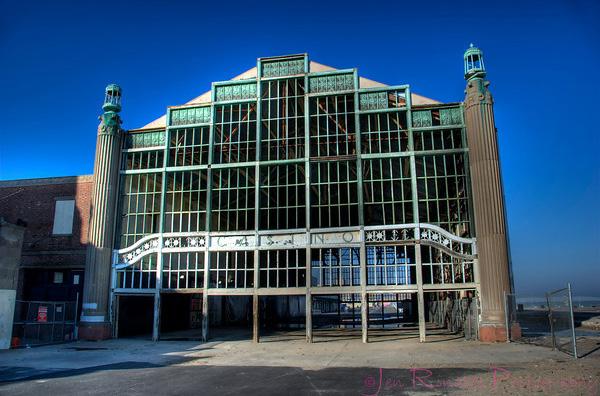




but
At 1.6 square miles and 16,127 residents (ESRI Community Profile, 2016), Asbury Park is a small but densely populated city on the coast of northern New Jersey. Since its founding it has been a seaside destination, with visitors flocking to its beaches every summer from around the region and New York City, which is an hour’s drive to the north. The city is physically divided in half along a north-south axis by train tracks that carry passengers up and down the coast, producing an East Side neighborhood between the tracks and the ocean and a West Side neighborhood on the inland side. After decades of economic decline, exacerbated by the Great Recession in 2008-2009, the city’s seaside tourism industry is once again thriving and attracting new restaurants, businesses, and residents at a breakneck pace to the downtown core of the East Side. But the benefits of that incredible resurgence have been uneven throughout the city.
The West Side is bounded by Asbury Avenue on the north, Main Street on the east, Boston way to the south and Ridge Avenue to the west. The West Side is 0.38 square miles with a population of 5,275 (ESRI Community Profile, 2016). Although the West Side has not experienced as much of the reinvigoration of the East Side in recent years, there are signs that the city’s newfound popularity is starting to spill over to the other side of the train tracks. Many of the vacant parcels along Springwood Avenue, the West Side’s historic commercial corridor, are seeing new construction pop up. Boston Way, a public housing property across the street from Lincoln Village, is in the middle of redevelopment, and a private affordable housing development is also underway.
Despite high distress, this neighborhood has unique assets that can be leveraged for market potential – a NJ Transit Commuter Rail Station with service to both Newark and New York City (Penn Station), the Boys & Girls Club of Monmouth County, the West Side Community Center, the City municipal government complex, the Springwood Ave and Washington Ave Redevelopment Areas.
These signs of change, strong local assets, and the momentum and capacity building that came out of the Choice Neighborhoods Planning process mean that the West Side is poised to transform equitably, sustainably, with minimal displacement.
Residents have spoken and they do not want a “tale of two cities” any longer. They aspire towards a revitalized, affordable, and inclusive neighborhood that supports their needs and their children’s futures.
RESIDENTS ASPIRE TOWARDS A HEALTHY, AFFORDABLE, AND INCLUSIVE NEIGHBORHOOD THAT SUPPORTS THEIR NEEDS AND THEIR CHILDREN’S FUTURES.



Throughout the Choice Neighborhoods planning process, invaluable connections and partnerships were created and strengthened, which will enable residents and stakeholders to overcome invisible barriers as well as physical ones. These new and reaffirmed connections between City agencies, the School District, regional entities, and local stakeholder organizations are the basis on which the plan will be implemented in the coming years. As part of the WFRF planning process, Interfaith Neighbors and its partners sought to build on these partnerships and remained conscious of “planning fatigue.” Interfaith Neighbors utilized several creative means to elicit valuable stakeholder input throughout the process yet being careful of not overburdening the community with ongoing meetings.
A steering committee was set up to analyze gaps between WFRF and Choice Neighborhood Planning process and to help focus the planning objectives for the WFRF planning effort. The goal was to develop a defined and complimentary process that can serve as a guideline for neighborhood reinvestment and to secure funding for implementation activities. The Steering Committee was comprised of West Side residents as well as members of local organizations and service providers active in the city. They met monthly between the months of January and May 2018.
The WFRF Plan engagement process included:
Summer 2017
Attendees at the weekly concerts in Springwood Park answered short survey questions while enjoying live music.
August & September 2017
Interfaith Neighbors staff completed a block-byblock survey of the West Side to gather data on building condition and vacancy.
Fall 2017
Neighborhood youth participated in a poster drawing contest. Winners were given awards and treated to a banquet celebration.
January- May 2018
The WFRF West Side Neighborhood Plan Steering Committee, made up of 17 local residents and stakeholders, met monthly in the first half of 2018 to guide the plan’s strategies and vision.
Spring & Summer 2018
A core group of local youth participated in several task force meetings to discuss their hopes and concerns for the West Side and advise on plan strategies. June 2018
Interfaith Neighbors staff and volunteers engaged with residents at the annual Super Safe Summer Festival, which encourages children and youth to get involved in summer enrichment programs.






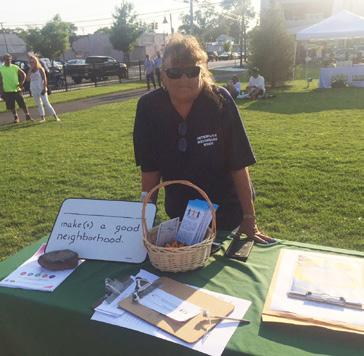

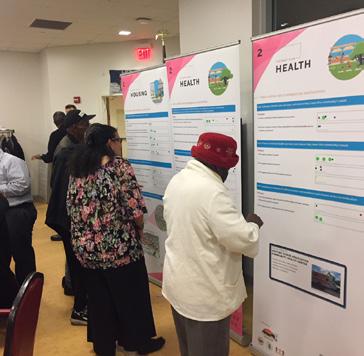

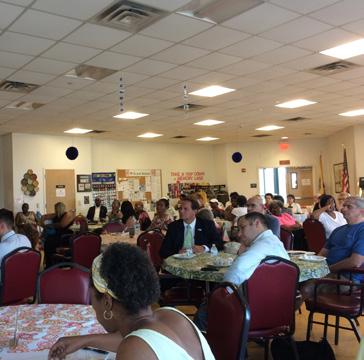


A key part of the Choice planning process was the Needs Assessment, a comprehensive survey that was tailor-made for the West Side. It asked residents a range of questions about their housing conditions, employment, health, and education status as well as involvement in local programs, transportation habits, and perceptions of safety. In total, 165 surveys were completed, including 45 Lincoln Village households. The survey questions were developed with input from residents and local stakeholders to ensure the questions covered issues unique to the West Side. It was administered by the Asbury Park Housing Authority as well as students and faculty from Monmouth University. A Spanish version of the survey was provided for Spanishspeaking residents, and one survey was administered in Haitian Creole through a translator. While the survey collection efforts were focused on capturing input within the Choice Neighborhoods planning boundary, several respondents live outside the boundary. However, because Asbury Park is such a small city, and because planning for the West Side will have impacts for the whole city’s future, input from households outside the boundary was deemed valid and useful.
WFRF requires all grantees to conduct a neighborhood satisfaction survey. Interfaith Neighbors conducted neighborhood satisfaction surveys in 2008, 2012, and 2016. The following represent several key findings when comparing the results of the 3 surveys.
• The percentage of residents who are renters has held consistent at about 70-75% between 2008 and 2016.
• The proportion of residents who wanted to buy a home in the neighborhood was 25% in 2008, dipped to 20% in 2012, and increased to 38% in 2016. The primary reason people pointed to for why they haven’t yet is their personal financial situation.
• The proportion of respondents who said they would recommend the neighborhood as a good place to live was 30% in 2012 and increased by 18 percentage points to 48% in 2016. The respondents are more likely to recommend the neighborhood to someone, families with children, and seniors.
• Every quality of life indicator asked about improved between 2012 and 2016, but “cleanliness of the community” and “physical conditions of homes” were among the lowest rated. The other aspects asked about were access to transportation, access to employment centers, variety of goods and services available, friendliness of neighbors, quality of public services, physical condition of streets, sidewalks, and public spaces, affordability of homes, and safety.
• In 2016 more than half of respondents said the neighborhood had improved a lot (56%) or some over the last three years, compared to in the 2012 survey (29%).



Asbury Park is a 1.4 square mile city that can be divided into 4 distinct quadrants – Asbury Ave as the north south divider and the NJ Transit tracks as the east west divider. The West Side neighborhood is the southwest quadrant of the city has the largest clustering of public housing units in the city – many of which are distressed or near-distressed. The West Side neighborhood is also home to the Springwood Ave corridor – a once vibrant neighborhood commercial corridor with deep African American heritage that was largely burnt down during race riots in the 1970s. This corridor is at the brink of rejuvenation with many currently vacant parcels slated for near term investments – 20 homeownership units and 220 new affordable rental units in addition to the recent investments of the Springwood Center and Springwood Park.
While the current image of the neighborhood is one associated with distress, Asbury Park’s east side (shore side) neighborhoods are experiencing an unprecedented amount of investment in the form of luxury rentals, condominiums, hotels and retail establishments. At the same time, portions of the West Side neighborhood, particularly areas in proximity to Springwood Avenue and the NJ Transit Station are experiencing escalated land values and speculative real
estate transactions. These market indicators signal that gentrification of the East Side is slowly encroaching onto the West Side.
...The West Side hosts four of the City’s six public housing sites, creating a concentration of lower-income residents.
92%
... of homeowner respondents have lived in their home for more than 6 years.
... home values in the West Side are lower than the City of Asbury Park and significantly lower than the County.
Asbury Park is a small but densely packed, primarily residential city. Most of the city is comprised of single family homes, although there are multi family buildings clustered in certain areas including along the waterfront, the southeastern part of the city around Cookman Avenue, and the southeastern corner of the West Side neighborhood. More and more market rate apartment buildings and hotels have been cropping up recently due to the city’s returning popularity as a beach vacation destination and music mecca. The major commercial zones are along Main Street and Memorial Drive, which are parallel to each other and run north-south through the center of the city; along Cookman Avenue, which connects Main street to the boardwalk; and finally along the waterfront.
The major green space in Asbury Park is Sunset Park, a long linear open space in the northern part of the city. Springwood Park, which opened in 2016, is the first and only public park on the West Side. There is a modest amount of light industrial activity in the city, including two breweries and a distillery, but no heavy industrial activity.
On the West Side, most of the housing stock is detached single family homes. There are also four public housing developments—three in close proximity to Springwood Ave and one further north on Washington Ave. There are a number of privately run, two- and three-story apartment buildings clustered near these sites. Springwood Ave, the historic commercial corridor on the West Side, is slowly being built back up with new mixed-income housing in the eastern portion, and the western end is meant to become a neighborhood commercial zone with retail and mixed-use development. The intersection of Springwood Avenue and Memorial Drive is conceived in City plans as
a future gateway zone with mixed use development and placemaking interventions. Asbury Avenue, the northern boundary of the neighborhood, hosts more auto-oriented commercial activity.
With a median household income of $25,396 (Esri community profile 2016) and home values on the West Side significantly lower than the rest of the city, the primarily low-income, African-American West Side community faces displacement pressures as prices continue to increase on the shore side of the city. The cost of both rental and for sale units in Monmouth County is typically higher than Asbury Park, giving displaced residents little choice outside of the city. The following maps from PolicyMap illustrate the displacement pressure that exists for current West Side residents and further demonstrates the need to develop and preserve quality affordable housing so that existing West Side renters and homeowners can continue to live in the city.
PERCENT HOMES AFFORDABLE TO HOUSEHOLDS BELOW 50% AREA MEDIAN INCOME

Credit: PolicyMap

PERCENT RENTAL UNITS AFFORDABLE TO HOUSEHOLDS BELOW 50% AREA MEDIAN INCOME

Credit: PolicyMap

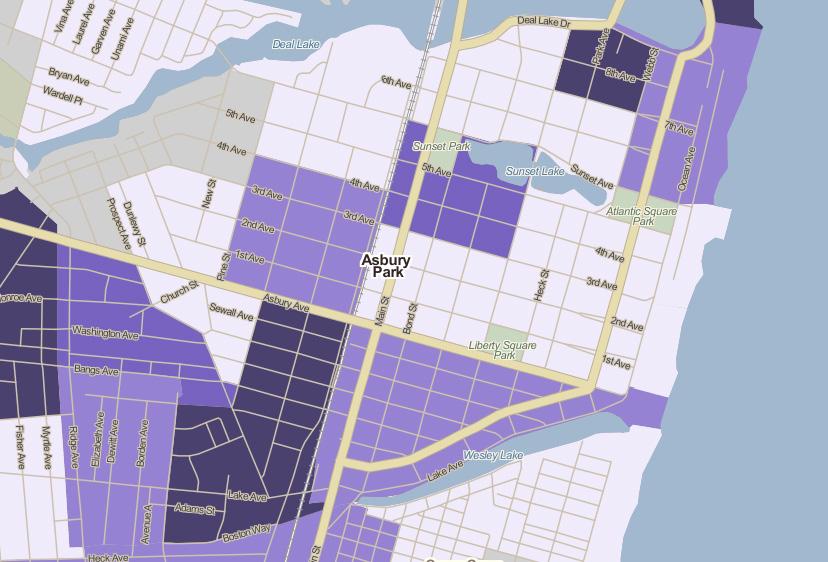
Credit: PolicyMap




With an unemployment rate of 5%, the state of New Jersey is at a level of “full employment.” With most state residents fully employed, employers will continue to struggle to find talent and replace employees as they enter retirement age. The elevated levels of unemployment that currently exist in Asbury Park and other New Jersey communities represents an untapped resource for area employers. Providing targeted training and comprehensive support to under- and unemployed Asbury Park residents will create a source of capable and qualified applicants to fill emerging jobs in the multiple industries including the healthcare industry.
The One Asbury Park: A Community Workforce Strategy, completed by the City of Asbury Park in 2017, outlines the workforce challenges and opportunities facing Asbury Park. The study notes that the City faces significant challenges in “ensuring a healthy, diverse, vibrant economy and highquality jobs for residents.” The study identifies “expanding career opportunities for all Asbury Park residents as the key to the economic vitality of the entire community while developing the talent required to support business growth and prosperity, and establishing a pipeline for the next generation of talent.” The future of Asbury Park is dependent on youth and young adults. Not surprisingly, these goals and strategies are very much aligned with the ones identified by stakeholders through the planning effort.
Specific aligned goals include:
• Support and grow local business.
• Expand and enhance career services for Asbury Park residents.
• Expand career exploration and planning resources available for youth.
• Increase employment opportunities and work experiences for Asbury Park youth.
WOULD
WOULD
WOULD
Based on the 2016 Survey respondents:
... of survey respondents are employed part-time and looking for full-time work
... of survey respondents said that their income does not meet their financial needs
... of survey respondents would like to participate in classes or training to gain skills for a current or new job
NOT ENOUGH JOBS IN THIS AREA
The majority of respondents believed that the greatest weakness in the neighborhood is lack of jobs
... of survey respondents have not heard of existing employment resources in the area
... of survey respondents with children expect their child to move on to a 4-year college in the future
While health can seem like an issue that affects us all equally, in reality there are large disparities in quality of life across socio-economic factors based on where you live. Research has shown that while there are some things that cannot be changed about one’s health outcomes, like genetic makeup, there are a number of factors that can have a large impact on overall health and longevity.
• Medical care: Access to medical care, quality of medical care and health insurance
• Personal behavior: Factors like cigarette smoking, alcohol and drug use, diet, exercise, and sleep habits
• Living and working conditions: Housing conditions such as housing quality, stability, and affordability; neighborhood conditions such as crime, blight, access to healthy foods, perceptions of safety, exposure to environmental risks, and social cohesion
• Economic and social opportunities and resources: Factors such as employment, income, and poverty status
The West Side displays a number of health-related challenges that need to be addressed. General health indicators like life expectancy and percent of residents with health insurance show that the West Side lags behind the rest of the county and wealthier parts of New Jersey. Other chronic conditions like asthma and heart disease are also elevated in the West Side. Asthma often afflicts lower-
income neighborhoods due to, among other factors, poor quality housing, which exposes adults and children to mold, pests, lead, and other toxins that may be present in old or poorly maintained homes.
Several health-related initiatives and organizations are already working in Asbury Park to improve health outcomes and create a culture of health. These include the Mayor’s Wellness Committee, which meets regularly and seeks to elevate and disseminate health-related information to the city’s residents. Also active in the West Side is the Alliance for a Healthier Asbury Park, a coalition of advocates and residents with the goal of improving the health and well-being of the community through prevention, education, active programs, and policy change. Ongoing initiatives include the Healthy Corner Store program, which encourages small stores to carry fresh produce. The Alliance released a Blueprint for Action in 2017, funded by the Robert Wood Johnson Foundation, with a comprehensive set of strategies being rolled out over the next three years.
... of West Side residents report having asthma, compared to 8.5% in Monmouth County
DEPRESSION
... of survey respondents say their household eats fresh vegetables every day
... of survey respondents have health insurance through Medicare or Medicaid
... of New Jersey residents have health insurance through Medicare or Medicaid
... of survey respondents say their health insurance covers mental health services
... of survey respondents say their children do not partake in physical activity because they don’t feel it is safe
The following is an additional overview of quantitative data sets and qualitative findings from the needs assessment on the topics of youth and education, housing, safety, and communication. Another important source of information that forms the basis of this plan is a comprehensive property survey that Interfaith Neighbors undertook in summer 2017; the results are displayed in the pages that follow.
This information serves to describe the community’s challenges and opportunities and reinforce resident stakeholder priorities for continued investment in the West Side.
... of West Side residents are under the age of 18
According to survey results, the top two most pressing challenges facing young people in the West Side: According to survey results, the top two reasons given for not participating in school resources/programs: #1 #1 #2 #2 NOT ENOUGH TO DO AFTER SCHOOL LACK OF INFORMATION EXPOSURE TO GANG ACTIVITY LACK OF INTEREST
...
... of renters in Asbury Park pay more than 35% of their income in rent
... of renters in New Jersey pay more than 30% of their income in rent
... of renters surveyed have had difficulty getting their landlord to address mold or infestations at least a few times in the past year
... of renters surveyed have had difficulty getting their landlord to make necessary repairs and/or standard upkeep at least a few times in the past year
SURVEY RESULTS
... of survey respondents were aware but not participating in, or unaware of, organizations currently operating in Asbury Park
According to survey results, most effective methods for receiving information about the community:
WORD OF MOUTH
PLACES OF WORSHIP
SURVEY RESULTS
HOW HAS THE COMMUNITY CHANGED OVER THE PAST 3 YEARS?
DECLINED SOME: 14% DECLINED A LOT: 10%
STAYED ABOUT THE SAME: 21%
IMPROVED A LOT: 14%
NEWSLETTERS + COMMUNITY HUBS
IMPROVED SOME: 42%
Over half of respondents saw at least some improvements in neighborhood conditions
potential public safety measure considered to be most effective
... of survey respondents say public art is important to a community’s quality of life and identity




The following three maps were created with data gathered from a neighborhood parcel survey conducted by Interfaith Neighbors in summer 2017.







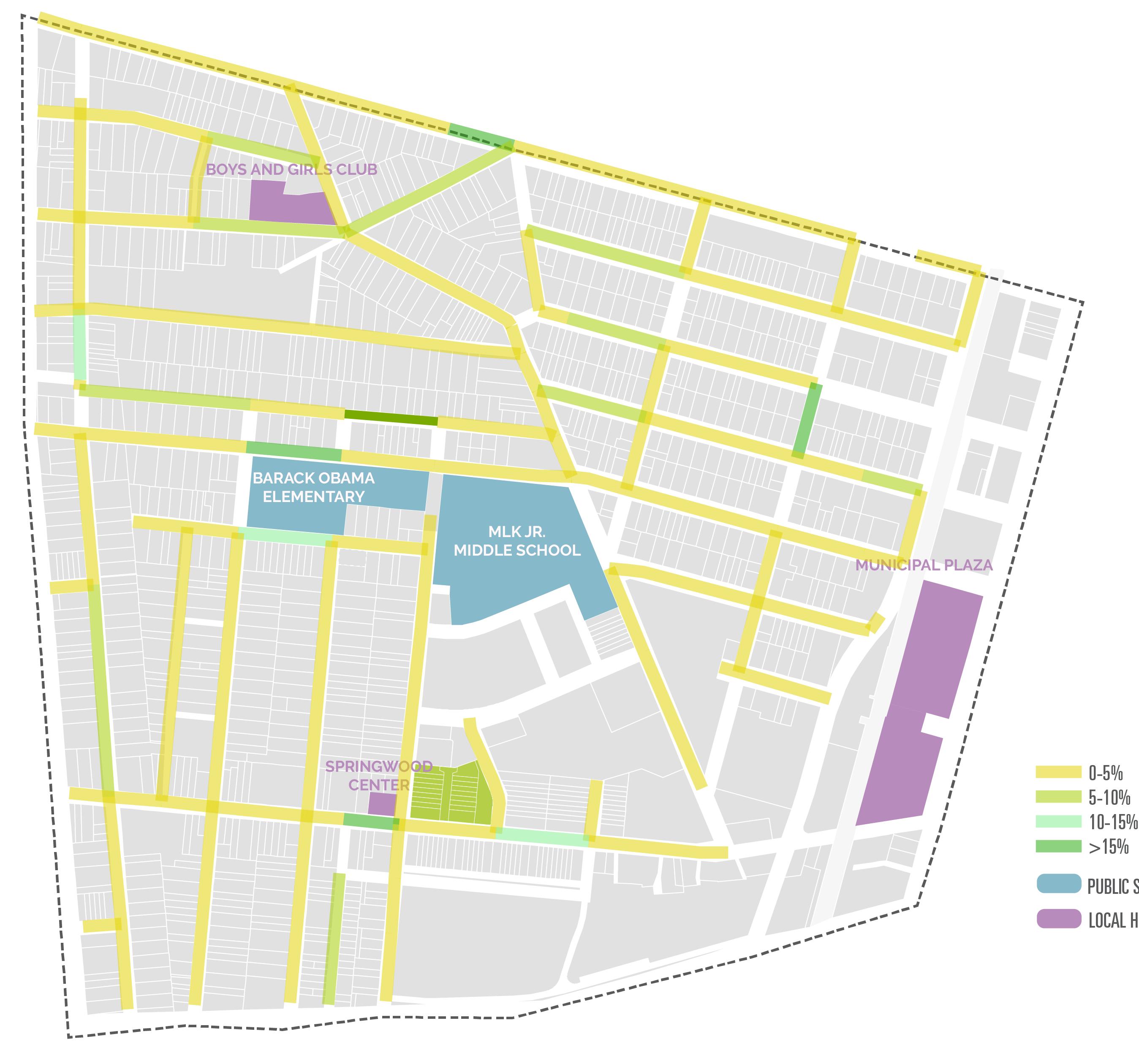
The West Side neighborhood includes several important assets, institutional anchors, and service providers within its boundaries. However, because Asbury Park is so compact, residents also utilize assets and services throughout the city and in neighboring towns.
One critical asset is the neighborhood’s network of churches and religious organizations. They are important sources of community engagement and information sharing, and residents often cite them as one of the neighborhood’s greatest strengths.
A cluster of relatively new neighborhood assets sit along Springwood Avenue. The Springwood Center, Kula Urban Farm, and Springwood Park sit at the intersection of Springwood and Atkins Avenue, creating a hub of activity and investment along the corridor. The Springwood Center is a mixed-use center housing a cafe, a business development center, a senior center, and affordable housing. Across the street, Springwood Park is the first piece of public open space on the West Side, which opened in summer 2016. Barack Obama Elementary School and Asbury Park Middle School are located within the West Side, although neighborhood children attend schools across the region. Hope Academy Charter School is a few blocks outside the neighborhood on the east side of Grand Avenue, where many West Side children attend. There are several programs and organizations that serve local children and youth, including the Boys and Girls Club, Big Brothers Big Sisters, Acelero Learning, and the City Parks Department. These entities provide enrichment opportunities, athletics, mentoring, and skills development for a range of ages.
Residents also travel throughout the region for health services. The VNA Community Health Center is within city limits, but many residents also utilize Jersey Shore Medical Center in Neptune and Monmouth Medical Center in Long Branch.
Persistent challenges facing the West Side include the at-grade New Jersey Transit train tracks, which physically and mentally separate the neighborhood from the tourism-driving East Side. Crossings are minimal and the underground pedestrian tunnel is closed at night. This is a major barrier that residents, advocates, and the City are hoping to overcome through a variety of programs and interventions. Other challenges include a concentration of low-income households that has persisted for decades. Residents are hopeful that new mixed-income developments will diversify the neighborhood.
As the rising momentum on Springwood Avenue would suggest, many new and exciting opportunities exist as well. Much of the vacant land on the eastern end of Springwood is slated for new residential or mixed-use development, which brings opportunity for residents looking for highquality, affordable housing; in the case of the Interfaith Neighbors Parkview AP homes, there are also new homeownership opportunities for residents ready to take that step. Planned and potential future development in the gateway and neighborhood commercial zones provide opportunities for local business owners to open or expand their ventures and for residents to have their desired retail options nearby.

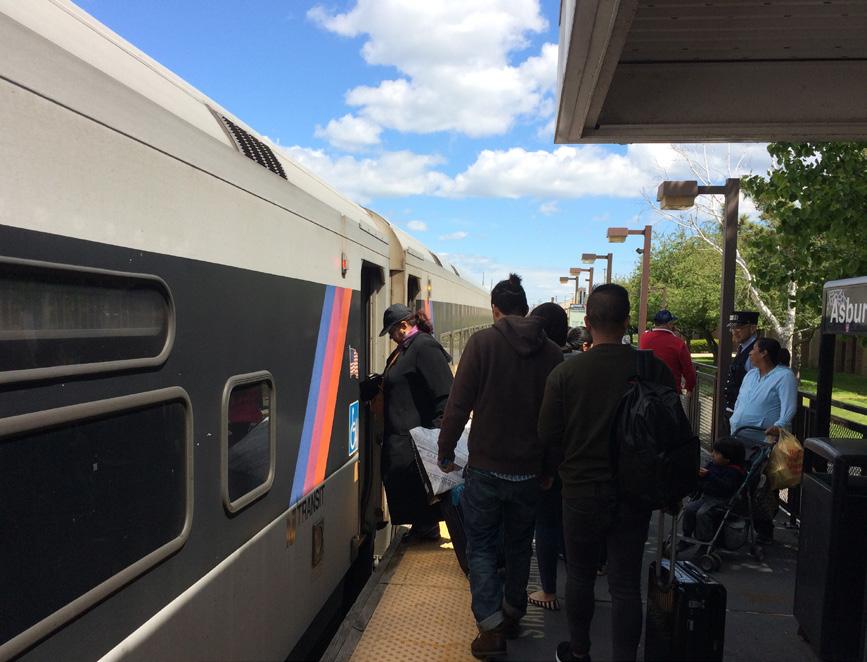

AT-GRADE RAILROAD TRACKS PARCELS
WASHINGTON AVE MONROE AVE
BOYS & GIRLS CLUB
JERSEY ST
SUMMERFIELD AVE
SUMMERFIELD AVE
MUNICIPAL COMPLEX AND NJ TRANSIT REDEVELOPMENT
ELIZABETH AVE
MATTISON AVE
PINE ST
CHOICE PLAN SCATTERED SITE HOMEOWNERSHIP
BARACK OBAMA ELEMENTARY
SEWALL AVE
MONROE AVE
AT-GRADE RAILROAD TRACKS
VACANT PARCELS
MLK JR. MIDDLE SCHOOL
MATTISON AVE PROSPECT AVE
LINCOLN VILLAGE REDEVELOPMENT
SPRINGWOOD CENTER & KULA FARM
SUMMERFIELD AVE BANGS AVE DEWITT AVE BORDEN AVE ATKINS AVE
SPRINGWOOD AVE COMMERCIAL ZONE
SPRINGWOOD AVE
SISTERS ACADEMY
ADAMS AVE CHURCHST
SPRINGWOOD PARK
UNION AVE
NEW RESIDENTIAL DEVELOPMENTS
COOKMAN AVE
MUNICIPAL COMPLEX AND NJ TRANSIT REDEVELOPMENT
POTENTIAL MIXEDUSE GATEWAY
MEMORIAL DRIVE AVE A
PARKVIEW AP RESIDENCES
ART PARK
 Fine Arts & Technology Camp attendees.
Credit: Interfaith Neighbors
Fine Arts & Technology Camp attendees.
Credit: Interfaith Neighbors

With an 11% unemployment rate and low average household income, the West Side neighborhood lags behind the City and the region in crucial economic indicators. Based on recent neighborhood surveys, respondents have shown low satisfaction responses to access to job opportunities (4%) and high responses for not buying a home in the community because of respondents’ financial situations (35%). Residents have strongly expressed a priority for strategies that will improve job prospects for residents, particularly young people, and for providing the right types of assistance that will enable residents to find meaningful work that meets their financial needs. While some resources and programs exist in the neighborhood, the need exceeds the current capacity. Bringing new resources closer to residents and expanding existing programs will improve economic circumstances for all residents. The first cohort will contain a maximum of 10 participants, but in full operation the program expects to “graduate” 30 to 50 individuals per cohort.
1. Through the newly launched SOAR Program, Interfaith Neighbors and its partners seek to tackle a host of job readiness and job search challenges that West Side residents face. It is an intensive, long-term employment and career preparation program that targets young adults and is designed to erase the stigma that employers associate with traditional job training programs.
... average annual income in the West Side
Beginning in 2017, the Second Baptist Church of Asbury Park has held a two-week camp every summer for children ages 4-17 centered around fine arts and technology skills. The hands-on program exposes children to music theory, dance, song composition and production, video production, creative writing, theater, and various technology concepts. It is designed to build digital literacy and expand students’ horizons beyond typical classroom topics. It also helps keep students engaged and learning new things before the new school year starts. This program is partly funded by Interfaith Neighbors and constitutes a precursor to the initiative outlined in Placemaking strategy 4 (page 70).
...West Side unemployment rate according to 2016 Census data
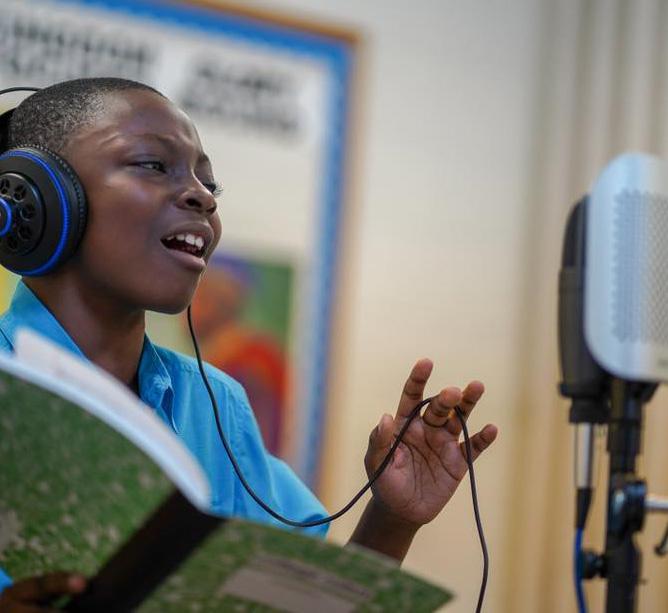
SOAR’s key focus areas are the following:
• Specific vocational training curricula for dominant industries in the region
West Side residents who are searching for a job or hoping to gain new skills that will lead to gainful employment lack access to a known, trusted entity that can support them through a complicated and often stressful process. Residents also desire training programs with a clear objective or job pipeline at the end of them, rather than gaining skills that are not grounded in the realities of the local job market.
This strategy dovetails with the City of Asbury Park’s Workforce Strategy, released in 2017, which prioritizes expanding the local economy in target industry sectors. The Monmouth County Workforce Board’s Local Plan identifies the following in-demand sectors and industries for Monmouth County: Health Care and Social Assistance; Accommodation and Food Services; Arts, Entertainment, and Recreation; Other Services (except Public Administration); and Management of Companies and Enterprises.
• Personal skill development and industry-specific training based on client’s interests and career goals
A major concern among residents is the lack of high quality jobs with advancement opportunities. Many people are stuck in low-wage jobs but want to advance to more fulfilling employment that meets their financial needs. The SOAR program aims to work with each job seeker to map out their goals and enable them to pursue a career that will fulfill them for the long-term.
In 2017, the City of Asbury Park released a comprehensive workforce strategy entitled “One Asbury Park.” The overarching theme of the strategy is creating one cohesive Asbury Park with no disparities, which is supported by three goals. The three goals are concerned with expanding career opportunities for all Asbury Park residents, developing the talent to support local business, and establishing the future workforce.
The plan focuses on issues like ensuring residents have access to year-round employment opportunities despite the city’s reputation as a summer destination, increasing coordination and collaboration among career training organizations in order to better serve people seeking to grow their skills, and setting up the city’s youth for successful future employment.

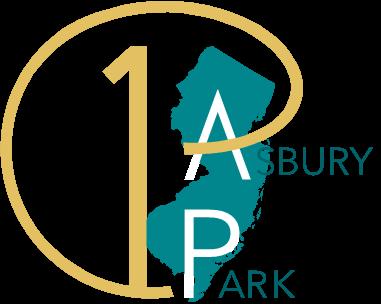

A COMMUNITY WORKFORCE STRATEGY
SEPTEMBER 2017

• Direct coordination with employers to identify market needs and match employers with a specificallytrained talent pool
The SOAR program aims to tackle the job pipeline issue from both ends: employers and potential employees. By working directly with area businesses, SOAR leadership will identify gaps in the local workforce and set up training programs that will create a crop of qualified workers ready to fill employers’ needs.
• Assistance in overcoming barriers to employment such as childcare needs, criminal record expungement, transportation, etc.
Many West Side residents face challenges that prevent them from getting or keeping a job, and often those challenges also keep them in minimum-wage and low-skill jobs instead of a meaningful career. SOAR will engage collaboratively with community based organizations in order to connect participants to programs and resources they need to succeed.
The Community Action Network of Asbury Park (C.A.N.) first realized the urgent concern of individuals in the Asbury Park community to get their lives back and assimilate back into society after facing the consequences of the justice system. Since 2016 C.A.N. has offered periodic expungement sessions at St. Stephens Church located on the West Side.

Record expungement session in progress.
Credit: Unheard Voices
...of needs assessment respondents either somewhat or strongly disagree with the statement “My job meets my financial needs”
Because of America’s employerbased health care system, finding full-time work with benefits can be a major positive change in a person’s overall health.

Kula Cafe trains residents to get jobs in the service industry.
Credit: Interfaith Neighbors

Springwood Avenue was once the bustling commercial and cultural heart of the West Side, but many of its blocks have been persistently vacant since the riots of the 1970s. As new development begins to appear and momentum builds, residents have expressed a need for convenient shopping, places to socialize, and businesses that are locally owned.
1. Work with local, regional and state entities to position West Side residents to qualify for leases and economic incentives that could support them in opening businesses within the neighborhood.
As Springwood Avenue continues to change, residents strongly desire that local aspiring business owners be afforded the chance to open a business and serve their neighbors. This will help keep wealth in the community and enliven the corridor with small, independent shops.
This strategy aligns with a major goal of the recently completed One Asbury Community Workforce Strategy, which is to support and grow local businesses. Potential partners and resources include the Workforce Innovation and Opportunity Act, the NJ Skills Partnership Grant program, the Recovery 4 Jersey Program, the City of Asbury Park Business Committee, and the local Chamber of Commerce. The corridor’s recent designation as a federal Opportunity Zone may also catalyze commercial investment: the zone allows investors to defer capital gains taxes on their investment earnings, with added incentive to maintain the investment over a number of years.
2. Work with developers to create a diversity of retail spaces that are accessible to local entrepreneurs just starting out as well as larger businesses that need more space.
... of surveyed residents feel that their community will “improve a lot” or “improve some” over the next three years.
Ardmore, PA
The Philadelphia suburb of Ardmore, PA established the Ardmore Initiative, which is a Business Improvement District and Main Street Program that strives to maintain a vibrant downtown commercial district in the town. The Main Street Manager for the commercial corridor manages the Façade Improvement Program, Business Assistance Program, and grant programs. The manager also assists with planning and development of new programs for the Ardmore Initiative, fundraising activities, and attends ongoing Main Street training through the Pennsylvania Downtown Center. All of these activities would be applicable to a Springwood Corridor Manager position, particularly business assistance and fundraising for events and improvements.

As more mixed-use development comes to the Avenue, local business advocates and the City of Asbury Park should work with developers to ensure a diverse mix of retail spaces. A more hands-on approach to creating the community-supported commercial vision will ensure the revitalization caters to residents’ needs.
3. Provide small business services such as consultation in marketing, advertising, tax prep, business model adaptation, and expansion.
Supporting small business owners to stay open will help ensure the neighborhood’s retail offerings stay local and put money back into the community. Some local businesses have struggled to stay open or have closed quickly. The Interfaith Neighbors Business Development Center, established in 2013, is currently providing these services as well as workshops, mentoring, and low-cost office space. Expanding and adding new support systems to help local business owners thrive will add vibrancy and stability to the corridor while nourishing the neighborhood’s entrepreneurial spirit.
4. Hire a corridor manager to provide assistance to businesses, bring resources to the corridor, oversee activities to make the corridor clean and safe, and work to attract new businesses to the area.
Springwood Avenue is on the cusp of transformation. According to the Springwood Ave Redevelopment Plan, the western end of the avenue is envisioned as a neighborhood commercial district, and the eastern end near Memorial Drive is envisioned as a mixed-use gateway. A dedicated corridor manager would work as a liaison between existing and potential businesses, the City, and the community to shape the
Improving and enlivening Springwood Avenue will encourage residents to walk to and along the avenue to enjoy it as a destination.
Jersey City, NJ
Many businesses throughout New Jersey were damaged during Hurricane Sandy. Wishing to jumpstart the recovery process, the New Jersey Economic Development Agency provided term loans and lines of credit to small companies through entities like New Jersey Community Capital. NJCC received $1.25 million between 2012 and 2015 to be directed to businesses in need of assistance. These loans have been awarded to a handful of local businesses on the East Side, including Cowerks, Langosta Lounge, Parlor Gallery, and the ShowRoom.
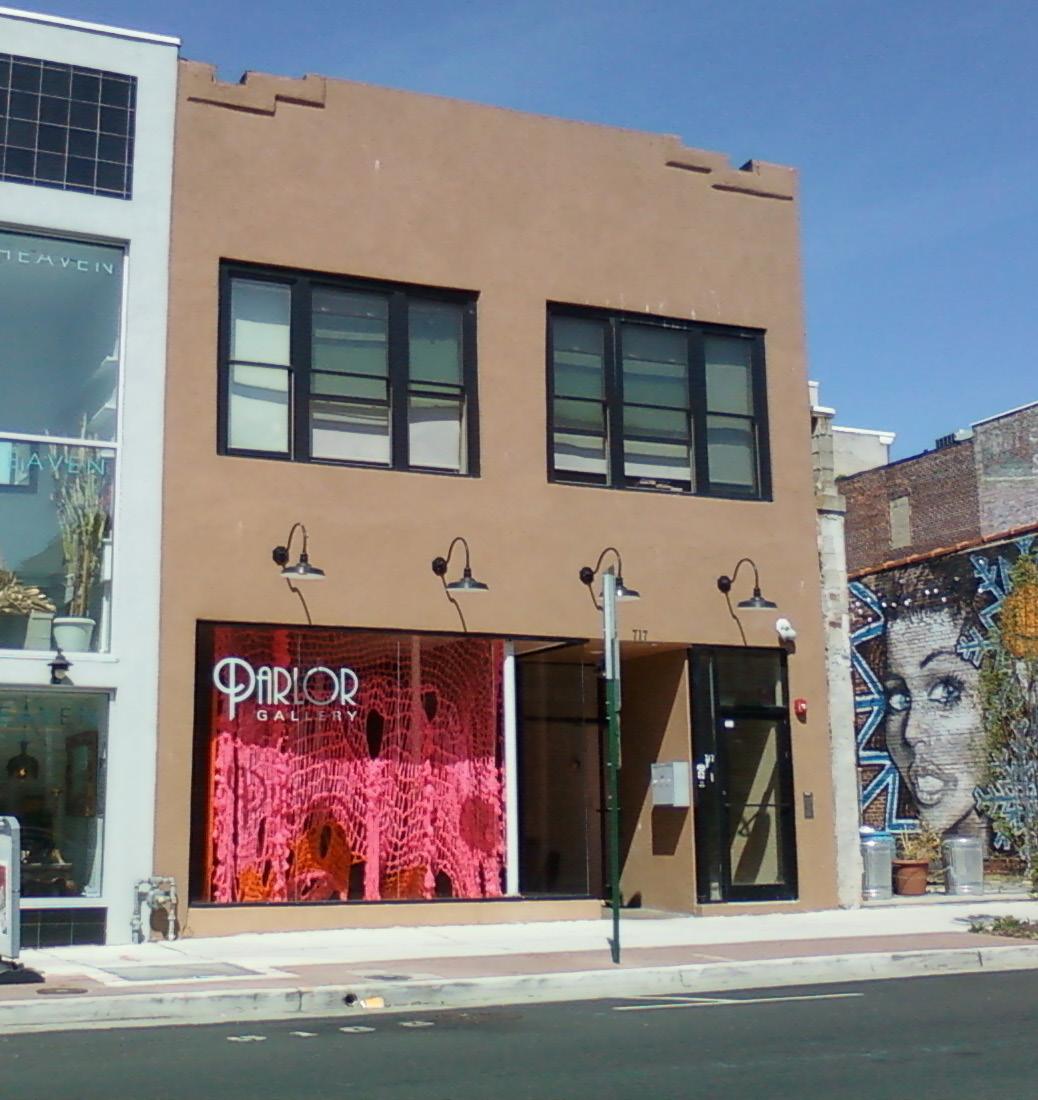
corridor in a coherent manner according to residents’ wishes. She or he would also act as a resource for business owners; facilitate and, in certain cases, arrange financing for programs and physical investments in the corridor; and advocate for new and improved services. This position would be need to be housed within the City government.
5. Encourage the development of restaurants and places to meet and gather along Springwood Avenue through outreach to potential retailers and marketing of existing municipal incentives.
There is a strong desire among residents to have new places in the West Side where people can get together, share a meal, socialize, and build community. This is also the vision embedded in the Springwood Ave Redevelopment Plan, which encourages a mixed-use neighborhood commercial zone on the blocks between Atkins and Ridge Aves.
6. Develop a neighborhood branding and marketing strategy tied to the City’s ongoing signage and wayfinding initiative.
The City of Asbury Park recently received funding from the New Jersey Department of Transportation for new signage and wayfinding investments throughout the city. The goal is to break down the perceived barriers between the East and West Sides, while celebrating the unique culture and history of both neighborhoods. A Springwood Ave corridor branding strategy would tie into these efforts so as be part of a cohesive identity.
... of surveyed residents report that the variety of goods and services available for purchase has increased, up from 32% in 2012
Newark, NJ
The Brick City Development Corporation (BCDC) works to retain, attract, and grow businesses, enhance small and minority business capacity, and spur real estate development within the city of Newark, New Jersey. Through direct client management and advocacy within city government, BCDC aims to produce and sustain economic growth and generate jobs and wealth for Newark residents. Programs administered by BCDC include small business loans, real estate services, business development training and assistance, and local hiring and relocation incentives, all of which are useful initiatives to be created or expanded in the West Side.





SPRINGWOOD AVE - BEFORE

SPRINGWOOD AVE - AFTER

Recent investments along Springwood Avenue include the Springwood Center, Springwood Park, and the soon to be built Parkview AP homes. There have already been some streetscape improvements with the addition of new street lights and street trees. Additional streetscape amenities will help create a safe, vibrant, pedestrian friendly environment that encourages activity. In keeping with the recommendations in the Amended Springwood Avenue Redevelopment Plan, these include:
» Pedestrian oriented decorative lights
» Benches to encourage social interaction on the sidewalk and provide a place to sit and relax
» Trash receptacles to help keep the Avenue clean
» Bus shelters for users of mass transit
» Complete Streets improvements to make the Avenue safe for all modes
» Rain gardens for stormwater management
» Street trees


As development momentum spills over from the East Side of the city, residents have a growing concern about maintaining affordability and expanding support systems for existing residents. They want to see investment in the neighborhood in the form of new housing options, but not at the expense of displacing people who currently live in the West Side. Residents have also expressed a strong desire for more homeownership opportunities-- more than twothirds of West Side residents are renters, but they recognize that homeownership is a crucial part of stabilizing the neighborhood and enabling current residents to benefit from the area’s resurgence.
1. Construct the Parkview AP Residences, a planned homeownership development by Interfaith Neighbors.
The Parkview AP Residences development will be a 20-unit community located on Springwood Ave across the street from Springwood Park. Each home will be constructed as a two-story ownership unit with a combination garage/rental unit behind it. This configuration will provide homeownership opportunities for 10 households, with the added support of an income-generating rental unit on their property (for a total of 10 rental units). Construction is expected to begin in early to mid 2019.
2. Expand the Pathway to Homeownership program, a rent-to-own program that enables families to work their way towards owning an affordable home.



The Interfaith Neighbors Pathway to Homeownership program works with prospective home buyers by providing a rental unit for a period of one to two years, during which $500 per month of the rent paid is deposited into an Escrow account, to be used in the future for a down payment and/or closing costs on their first home. Interfaith Neighbors is developing a new 2-unit rental home for program participants on Borden Ave in the West Side.
3. Expand the “Rights of Passage” program in partnership with Covenant House, which provides transitional housing for at-risk youth.
For many years, Covenant House has served at-risk and homeless youth throughout New Jersey. Through the Rights of Passage program, homeless residents live in semi-independence for up to 18 months while they learn financial skills and access counselors. Given the relatively large number of homeless youth in the Asbury Park area, Interfaith and Covenant House have agreed to work together to establish a second Right of Passage facility in Asbury Park. Interfaith Neighbors will develop and retain ownership of the property and lease it to Covenant House. The facility will accommodate up to five female residents at a time.
4. Expand rental assistance programs.
Many West Side residents struggle to keep up with rent payments, given the neighborhood’s low average annual income of $39,536. Interfaith Neighbors began as a homeless prevention agency 30 years ago. It is still one of their principal programs, helping about 320 families a year with partial, direct rent subsidies, totaling more than $500,000 annually. Part of this assistance is made possible with federal Social Service for the Homeless (SSH) funds. The SSH
Neptune, NJ
Stress related to difficulty paying rent and eviction can contribute to worsening mental and physical health.
In response to the overwhelming need for quality, affordable housing in Monmouth County, the Monmouth Housing Alliance was formed in April, 1991 with a start-up grant from the Robert Wood Johnson Foundation and has been now renamed as the Affordable Housing Alliance (AHA).
AHA assists any first-time home buyer to determine their mortgage readiness and understand the home buying process by providing group workshops and one-on-one home buying counseling through their Housing & Rental Assistance, Home Buyer Programs, and Home Owner Preservation Programs. During Impact year 2017, AHA helped over 2,300 families in their homeownership journeys.

program provides assistance by paying the first month’s rent, rent arrears, security deposits and utilities to individuals and families at risk of becoming homeless. The Community Affairs and Resource Center (CARC) also disburses SSH funds to families throughout the city. Securing future funding for that program, as well as new and expanded similar programs, will help Asbury Park residents stay in their homes. It is important to note, however, that expansion of this vital service is largely contingent on County-level funding decisions.
5. Develop a comprehensive homeownership course that assists residents before, during and after the purchase of a home.
Many homeownership courses only help prospective homeowners before they actually purchase a home, which means the homeowner is left with little support during the crucial time when they are adjusting to being a homeowner and dealing with new or surprising challenges. A comprehensive course would help residents before, during, and after the home buying process in order to help them navigate things like saving up to pay for home repairs, paying property taxes, etc. Interfaith Neighbors has long offered support for new homeowners who purchase affordable homes constructed by Interfaith Neighbors. An expanded program would help a broader population of homeowners in the neighborhood.

Through public input and the property survey, it is clear that there is significant neighborhood pride in the West Side but it is not necessarily always reflected in the physical quality of homes, streets, and general upkeep. Many residents would like to make improvements to their homes but lack the funds or have a hard time getting the landlord to keep up the property. Programs like Coastal Habitat for Humanity’s “Brush with Kindness” and the recently launched “Love Your Neighbor” are prime examples of positive, community-building efforts to improve neighborhood housing quality. Using a variety of “carrot and stick” methods will further build community pride and improve quality of life.
1. Continue to expand the City’s property and zoning code enforcement efforts.
Encourage City administration to expand use of the Abandoned Properties Rehabilitation Act’s legislative toolbox, including “spot blight eminent domain,” to address remaining dilapidated and unoccupied structures on the City’s West Side. Municipalities may use the procedure known as “spot blight eminent domain” to acquire privately owned abandoned buildings and make them available for reuse.
2. Rehabilitate qualifying affordable single family homes in the West Side with RCA funds by re-branding the program, reaching out to qualifying homeowners, and leveraging related grassroots efforts.
...of surveyed residents have had trouble getting their landlord to make necessary repairs and/or standard upkeep at least once in the past year.


Poorly maintained housing and the presence of mold, pests, and toxic materials can contribute to health issues like asthma and allergies.
The City of Asbury Park has funds that were allocated to them as part of the distribution of affordable housing funds statewide. The Regional Contribution Agreement (RCA) Home Rehabilitation Program rehabilitates substandard single family, owner-occupied, and multi-family investment (up to four units), for low- to moderateincome families with a least one major building system to be replaced or repaired. Major systems include: Heating, Roofing, Plumbing, Weatherization, Electrical, Sanitary Plumbing; and Structural (Load Bearing). While considerable funds are still available, there is a low level of awareness of the program. Rebranding it in a more easily understood way and proactively reaching out to homeowners who could qualify will enable the City to disburse funds more quickly and assist local homeowners in need. Additionally, because there are strict requirements in order to qualify, the City and other entities carrying out similar programs could coordinate to ensure a homeowner who may not qualify for one program is then referred to another program that may better suit their situation.
3. Expand the newly launched Coastal Habitat for Humanity “Love Your Neighbor” block cleanup program.
The “Love Your Neighbor” program is aimed at helping homeowners with repairs while building community cohesion and a ripple effect of neighborhood improvement. The home improvement project becomes an event involving interested volunteers on their block, and other minor block improvements will be made at the same time. The program will improve quality of life for all residents on the block while developing connections between neighbors and building leadership capacity for future local endeavors. It will also complement the other physical improvements and new developments occurring in the rest of the neighborhood.
Launched in summer 2018, The Love Your Neighbor program engages neighboring residents to assist in both the work being done for their neighbor and in a greater micro-neighborhood cleanup. Participating residents work with collaborative partners to immediately remedy existing block problems like trash and overgrown vegetation while also exploring strategies to handle more significant needs such as additional housing in need of repair, lacking city services, poor rental conditions, and poor lighting. Participating residents are then encouraged to take on leadership roles in the ongoing work identified on their block.
The program jumpstarts façade improvements in the neighborhood and creates momentum for beautification projects in the future, while also developing social cohesion by bringing neighbors together to work towards a common goal while getting to know each other better. Through Love Your Neighbor, the West Side neighborhood will develop a better sense of community and pride of place.

4. Continue to expand and support Coastal Habitat for Humanity’s “Brush with Kindness” home improvement program.
The Brush with Kindness program organizes volunteer groups to help local residents who need help making repairs to their homes but cannot afford to do so. Labor and materials are donated for improvements like weatherization, repainting, porch repair, or accessibility upgrades.
5. Install commemorative trash and recycling bins for blocks that have participated in the “Love Your Neighbor” program.
The Love Your Neighbor program aims to produce lasting quality of life improvements on neighborhood blocks while building a sense of community. A plaque or other permanent fixture commemorating the effort would promote a sense of pride among neighbors while spreading awareness of the program to other interested residents.
6. Expand the use of municipal tools to manage and rehabilitate vacant and abandoned properties, including the New Jersey Abandoned Properties Rehabilitation Act.
Residents have expressed both a frustration with absentee landlords who do not take care of their properties and an interest in becoming homeowners. There are various “carrot and stick” mechanisms that Asbury Park can use to turn abandoned and dilapidated housing into affordable homeownership opportunities. The City will also update its vacant properties list to provide an accurate picture of vacancy in the city.
...of surveyed residents said they were interested in buying a home in the neighborhood.

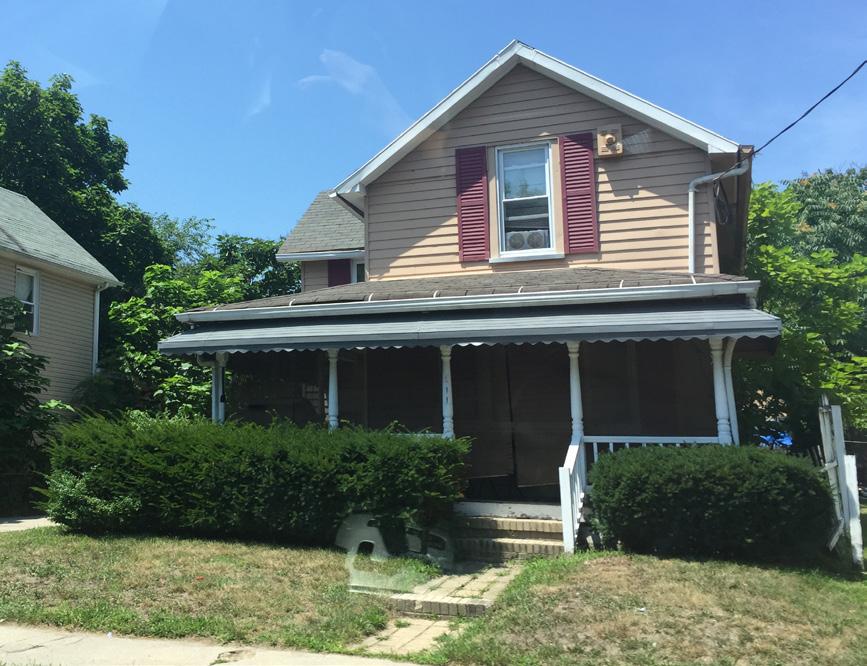

The West Side has a rich history that many still remember and speak of today. Finding ways to showcase the neighborhood’s legacy while creating new spaces for residents to enjoy and enhancing community cohesion will foster a new era and tie the West Side’s identity to its past.
1. Encourage more placemaking opportunities with community and youth support and participation, such as special events, block parties, designing gateways at key intersections, and new or expanded public spaces.
As part of the One City. Asbury Park. Choice Neighborhoods Plan, completed summer 2018, multiple community-driven placemaking projects were undertaken in the West Side. For example, in October 2017, two blocks of Springwood Ave were transformed by a Better Block tactical urbanism event. Temporary and permanent improvements were installed, such as a parklet and protected bike lanes, to give residents a sense of what a transformed Springwood Ave could look like in the future. In addition, in spring and summer 2018 two City-owned parcels near Asbury Park Village were developed into a park with benches, plantings, and artwork created by local artists and neighborhood youth. Building on these efforts will enable the community to continue to be involved in beautifying their neighborhood.
2. Create a heritage walk celebrating the history of the West Side.
The West Side has a rich history as the hub of African American life and culture in the middle of the 20th Century. Jazz and blues clubs dotted Springwood Ave, as did numerous black-owned small
Kula Cafe infuses its menu with nods to the neighborhood’s past with dishes like “Kershaw’s BBQ Chicken Sandwich,” “Griffin’s Burger,” and “Fisch’s Quesadilla.”

In October 2017 a “Better Block” festival was held, with temporary and permanent fixtures meant to show residents what a revitalized Springwood Ave could look like.
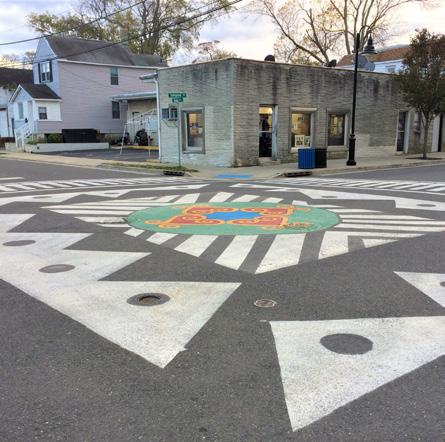

A one-of-a-kind street mural was painted at a key intersection in summer 2017, meant to reflect the culture and musical history of the neighborhood
A new “Art Park” opened on city-owned land in spring 2018. It features passive walkways, plantings, and public art made by local artists and youth.
WASHINGTON AVE

JERSEY ST
Springwood Park, which opened in spring 2016, was the first open space built by the city in the West Side. It hosts a weekly concert series every summer.
SEWALL AVE PINE ST
MONROE AVE
SUMMERFIELD AVE
ELIZABETH AVE
MATTISON AVE
DEWITT AVE BORDEN AVE ATKINS AVE
PROSPECT AVE
SUMMERFIELD AVE
BANGS AVE
MATTISON AVE
ATLANTICAVE COOKMAN AVE
MEMORIAL DRIVE AVE A
ADAMS AVE
SPRINGWOOD AVE
PLAN BOUNDARY

Asbury Park’s bikeshare program rolled out citywide in the summer of 2018. There are currently three stations in the West Side, including one at Springwood Park.
BOSTON WAY

New street trees and coordinated street lighting was added to the avenue in conjunction with the construction of Springwood Park.

Kula Urban Farm was expanded onto a vacant lot along Springwood Ave in summer 2017 to increase production, provide seasonal employment for West Side residents, and spruce up a previously unattended space.
businesses and restaurants. Many residents remember this history, but there is almost no trace of it left. Once the corridor is more built out, creating a heritage walk with plaques and other design features that bring to life the West Side of the past will draw visitors and connect residents to history. This effort could also be expanded into a citywide heritage walk, linking the history of the Jazz era on the West Side to the past and present musical culture of the East Side.
3. Develop a campaign to add murals throughout the neighborhood that reflect and celebrate the past, present, and future of the West Side, utilizing local artists to the greatest extent possible.
Murals are a creative way to showcase a neighborhood’s identity and cultural history, engage the local art community, and bring residents together through public art. As redevelopment along the avenue continues, a targeted strategy for adding new murals will help enliven the corridor and add an interpretive dimension to West Side identity and branding.
4. Develop a community-driven cultural and economic opportunity center at a key location in the neighborhood.
Interfaith Neighbors aspires to develop an arts and cultural-centric mixed use building along Springwood Ave, with an aim to enhance the public realm at a key intersection. The multi-purpose space would accommodate programming designed to attract and engage local
...of surveyed residents say public art is important to a community’s quality of life and identity
Washington, DC
The nonprofit coalition Cultural Tourism DC established the African American Heritage Trails. Sites were chosen based on their ability to tell multiple stories of African American history and culture along DC’s streets. Priority in the site selection process was given to sites that still exist and can be visited today. Other criteria for site selection include geographic diversity in the city, representing a “first” of a building type, or representing a noteable person or event. Sites on the ‘trails’ (existing city sidewalks and trails) include plaques with information and historic images. The program is funded by the District of Columbia, Office of the Deputy Mayor for Planning and Economic Development, DC Department of Transportation, and the National Park Service.
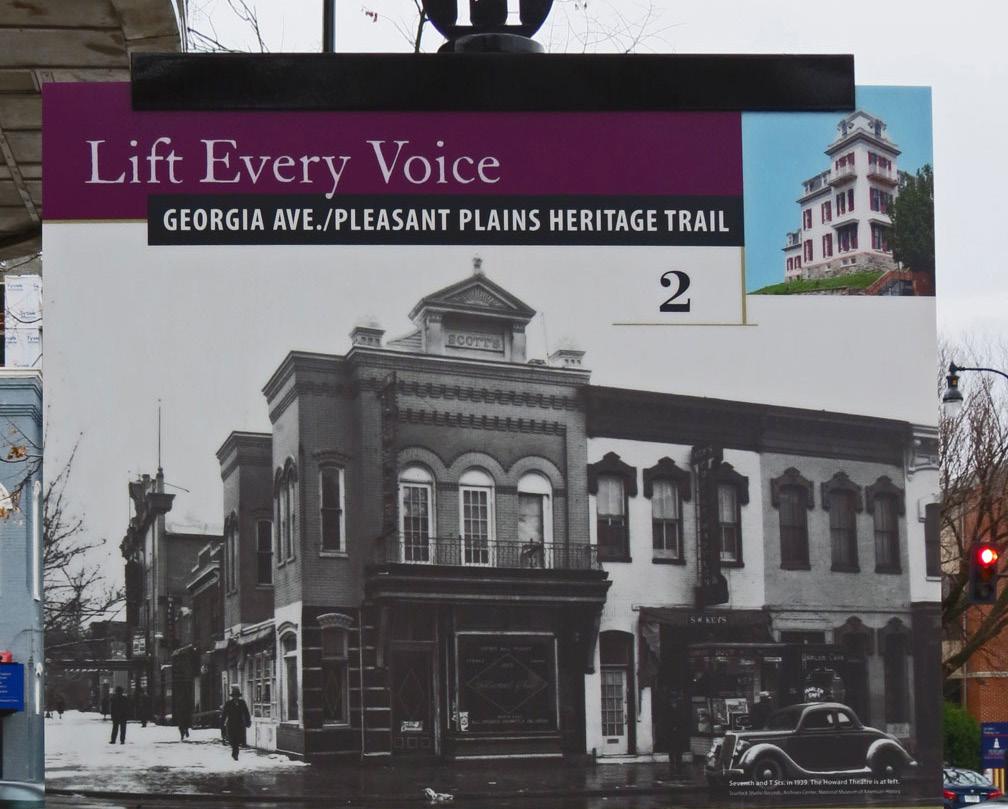
residents, particularly youth and young adults. This state-of-the-art, world class facility would also be designed to celebrate and showcase the West Side’s rich musical and cultural heritage. It could also provide permanent exhibition space for the “Springwood Avenue Harmony: Celebrating the West Side’s Unique Musical Legacy” exhibit.
The presence of trees, green space, and high quality public space is linked to improved mental health outcomes.
Made possible in part by Choice Neighborhoods funding, the new Art Park in the West Side neighborhood is making positive use of undevelopable City-owned land. The new park sits at the southern edge of the neighborhood, adjacent to the Asbury Park Village public housing site. It is a small passive park that features community art created by local artists in collaboration with local students. The rest of the park is landscaped with trees, flowers, shrubs, and includes benches and bike racks.
Volunteers and the Asbury Park Environmental Shade Tree Commission worked throughout the spring and summer of 2018 to make the park a reality. Volunteers will continue to be recruited to take part in regular maintenance and upkeep.

Many of the types of changes West Side residents would like to see in their neighborhood can be encapsulated in the desire for a healthier, thriving neighborhood. Both physical improvements to the public realm and new programs aimed at improving physical and mental health and wellbeing will help create an identity for the neighborhood as a hub of healthy living.
1. Expand healthy food choices in the neighborhood through expanded community gardens, a farmer’s market in Springwood Park, healthy foods at corner stores, and partnerships with local schools.
Several healthy food initiatives are underway in the neighborhood and are ripe for expansion and further support. Interfaith Neighbors recently expanded their Kula Urban Farm program, which resulted in a significant increase in production of fresh fruits and vegetables to be sold to residents, used in the Kula Café, and sold to local restaurants around the city. A healthy corner stores initiative was also launched in 2018 by the Alliance for a Healthier Asbury Park, with several local stores participating. Adding a farmers market in Springwood Park, and finding innovative ways to partner with local schools to promote healthy foods, will build on the momentum around promoting healthy lifestyles.
2. Improve access to and opportunities for physical activity.
While many residents report being physically active on a frequent basis, others report a desire to make exercise more convenient, safe, and affordable. This can be achieved in multiple ways: by advocating
...of surveyed residents report that someone in their household has high blood pressure
Asbury Park, NJ
The West Side is identified as a “food desert” by the State of New Jersey, meaning residents here lack sufficient access to fresh food.
Opened in 2014, the Kula Urban Farm Project is a social enterprise created by Interfaith Neighbors to bolster the economic outlook of the West Side while providing fresh produce to the community. Part of the farm is a commercial enterprise, selling plants, vegetables and leafy greens to customers and local restaurants, paired with an educational garden intended to foster entrepreneurial activities and healthy lifestyles on the part of residents. The farm also distributes fresh food for free to those in need. Produce is grown in a greenhouse using hydroponic technology, allowing for year-round production. Outside, raised beds are cultivated during warm months. All produce is grown without the use of pesticides. In 2017 the farm was expanded with additional hydroponic growing equipment and a rainwater capture system for the hydroponically grown produce.

for new and expanded facilities while also working collaboratively to more fully use the spaces that the West Side already has, including two public schoolyards and the Boys and Girls Club. In addition to specific facilities, ensuring high quality sidewalks, bike lanes, and a general feeling of safety will encourage more people to walk, run, and bike throughout the neighborhood. Forging and strengthening partnerships will be crucial in achieving more plentiful opportunities for physical activity for residents of all ages.
3. Improve access to affordable health care and mental health services.
With over 20% of West Side residents uninsured and many residents reporting being unaware of local health care facilities, access to health care services is a key concern. Supporting and expanding resources like health fairs, insurance sign-up drives, and working with partners to raise awareness of existing physical and mental health resources in and near the West Side will help reduce the health gaps that exist.
4. Enhance the function and beauty of streetscapes for multi-modal use through new plantings, green stormwater infrastructure, and street trees.
Many residents have cited litter as an ongoing challenge in the neighborhood. Improved maintenance of streetscapes throughout the West Side will enhance quality of life and create a more pleasing atmosphere for pedestrians. The additional utilization of green stormwater infrastructure and native plant species will further beautify the neighborhood while providing benefits of improved drainage and lowered maintenance needs. Increased trees and vegetation in neighborhoods have also been linked to positive health outcomes like better air quality and mental health benefits.
The City of Asbury Park recently completed a pedestrian and bicycling master plan, in which they identify existing issues and deficiencies and develop comprehensive improvement strategies in order to conveniently connect residents and visitors to destinations within Asbury Park, as well as linkages to adjacent communities. The plan will provide a blueprint for bicycle and pedestrian improvements that will help the City make its streets more accommodating for users of all modes, ages, and abilities.

5. Prioritize safe, comfortable, and attractive non-vehicular linkages to destinations and amenities throughout the West Side.
The City of Asbury Park recently completed a pedestrian and bicycling master plan, in order to better connect residents and visitors to destinations throughout the city. Asbury Park is already a compact city with walkable blocks, but making streets and sidewalks safer and more inviting for pedestrians and bicyclists will encourage more residents to use active forms of transportation in their daily lives.
6. Improve access to quality affordable housing for all residents.
Research has shown the connection between poor quality housing and poor health outcomes, from asthma to exacerbated allergic reactions. Expanding the availability of high quality affordable housing in the West Side will help ameliorate these issues for occupants, while also relieving the stress related to rising rents.
...of surveyed residents report jogging, walking or biking outside every day
Asbury Park, NJ
Safe Routes to School is a nationwide initiative to encourage safer and more accessible walking and bicycling environments for children through education, training, and physical improvements. Bringing this program to Asbury Park in 2014 was one of the Alliance for a Healthier Asbury Park’s first efforts. In 2018, Asbury Park was named a Gold Level winner in the SRTS Recognition Program, which recognizes municipalities for their commitment and support. Activities that warranted such a distinction included multiple Walk to School days with local leaders, Bike Rodeo seminars to teach students how to ride, crossing guard observation and training, and adoption of a School Travel Plan that sets guidelines for safety. Winners are eligible for SRTS infrastructure grants to help expand the city’s investment in student safety.
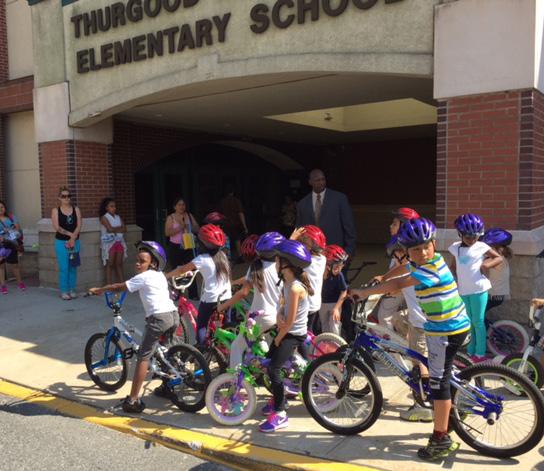

Creating a positive atmosphere for youth and enabling them to flourish as adults is a major concern for all West Side residents. Expanding youth resources that already exist while embarking on new strategies will help ensure that all of the neighborhood’s young people are poised for a bright future.
1. Expand outreach for existing adult literacy, GED and ESL programs available in the region.
According to the Choice Neighborhoods Needs Assessment Survey, 50% of survey respondents reported that not having enough education is a major obstacle for them. Existing programs in the region include GED and ESL courses at Brookdale Community College as well as ESL courses at CARC right in Asbury Park. Better communicating the availability of these crucial resources will help adults and young people improve their job prospects.
2. Expand tutoring and enrichment programs for school-aged children and youth, including academic programming as well as extracurricular enrichment.
A major goal and source of concern for West Side residents is improving the academic achievement and future potential of the neighborhood’s youth. Expanding existing tutoring programs— at the Boys and Girls Club and at Big Brothers Big Sisters, for example—and investing in new tutoring and enrichment programs would foster learning as well as provide a productive place for young people to be after school hours. Potential enrichment activities include cooking, theater, exercise classes, events with the Asbury Park Police


Department, and public speaking, which were suggested by the WFRF Neighborhood Plan Youth Task Force.
Interfaith Neighbors has provided financial support for existing programs through NRTC Program for the past decade and remains committed to funding an expanded set of options for local youth.
3. Reinvigorate and expand collaborative and mentoring programs involving youth and Asbury Park Police Department officers.
According to the Choice Neighborhoods Needs Assessment Survey, 40% of survey respondents said that they personally knew a police officer they could contact if they needed help. Strengthening the ties between residents— particularly young people— and law enforcement officers is critical to community cohesion. Existing programs that work towards this goal include the APPD Police Cadet youth mentoring program, which serves youth ages 10-12, and the Police Athletic League, which brings officers and youth together through sports. Expanding these efforts would bring more local youth into positive relationships with police officers and build community trust.
4. Identify and implement programs for youth ages 14 and above seeking first time employment and/or workplace skills in order to both explore and generate interest in later career paths through mentorships, career days, and networking events.
The Boys and Girls Club recently launched a pilot of Project L.E.A.D. This teen empowerment and employment program will help youth develop skills needed to succeed in life by focusing on mentorship, employment, and educational attainment. The Boys and Girls Club will then establish a partnership with the Interfaith Neighbors job readiness program and the Job & Career Readiness Coordinator at Asbury Park School District in order to source program participants.
Launched in summer 2018 by the Boys and Girls Club of Monmouth County, Project L.E.A.D. (Learning, Earning, and Advancing Dreams) aims to empower youth to develop the skills they need to succeed in their future careers. A kickoff session and workshop was held in June 2018, where over 40 teens received career coaching and professional development training. The most promising and engaged participants then went on to hold youth development internships at the Club over the summer. This program is partly funded by Interfaith Neighbors.
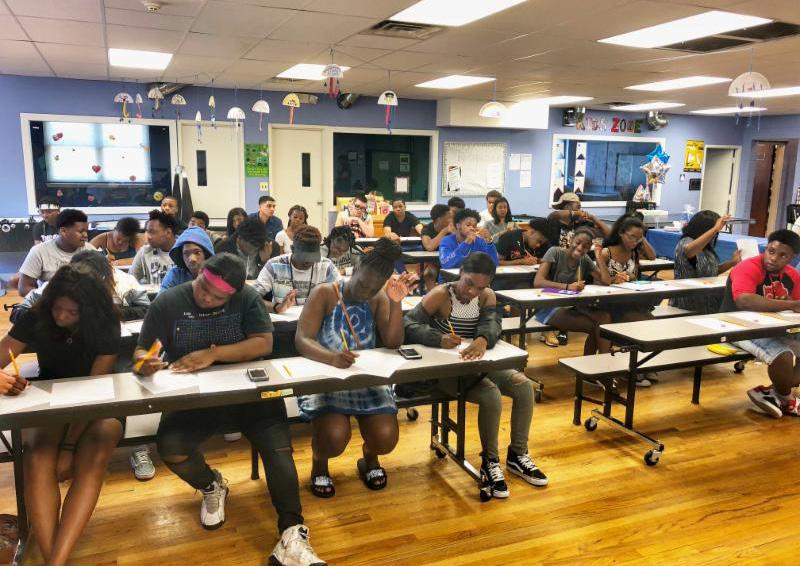
5. Expand summer academic programming to bridge the gap in the school year and minimize the “summer slide.”
While some local summer programs for academic enrichment exist, residents have expressed a desire for more options and availability. Interfaith Neighbors currently sponsors a fine arts and technology summer program at Second Baptist Church and an Introduction to Video Production summer workshop developed by The Showroom. Interfaith Neighbors has also worked with Mt. Carmel School on similar programming in the past. Other programs include camps run by the Asbury Park School District. Expanding current offerings will help ensure all students come back to the new school year ready to build on the previous year’s knowledge.

...of surveyed residents with children say they expect their child to go on to a four-year college after high school


Communication is a major challenge for the West Side neighborhood. Over and over again, residents have expressed frustration with not knowing about the existence of a program that could help them or their children. This is a unique neighborhood, in that a majority of residents report word-of-mouth to be the primary way they receive information. Rather than trying to overcome that fact, these strategies build on the West Side’s information networks and seek to channel them productively so that all residents are empowered to take advantage of the programs and services around them.
1. Convene a coalition of local and regional service providers to exchange information and create a clear system to keep each other informed of programs/services on a regular basis.
Participants would take turns hosting these meetings on a monthly or bi-monthly basis, with the host organization starting by briefly presenting on their work and any upcoming new initiatives or activities. Round-robin hosting of general information sessions has been done periodically in the past both for and by Asbury Park based service providers; Interfaith Neighbors is developing concept for permanently housing service provider space to address a broad range of neighborhood resident needs.
2. Set up an electronic message board at a key intersection along Springwood Ave or at Springwood Park, updated regularly by the City communications department.
...of surveyed residents were aware but not participating in, or unaware of, programs currently operating in Asbury Park
Kent, OH
In cooperation with the city and Kent State University, the Kent electronic message board is at the gateway intersection of Haymaker Parkway and Water Street, the main downtown street of the city. The $92,000 sign stands at 80 in x 168 inches. The cost was split between the city and university and will rotate news about events that either party is sponsoring. The City financially sponsors the Chamber, Main Street Kent, and DICE events, which will enable future advertisements for events on Water Street. Items from the university include athletic events, speakers, and school sponsored entertainment, while the City advertises public meetings, festivals, and medical events. Advertisement for the sign has already given events larger turnout as the intersection receives heavy auto and pedestrian traffic.

Many residents struggle with finding out information about available programs, services, and events. Meeting residents where they are—on the avenue— will push information to them without them having to take time to attend a meeting. The City recently installed a message board at a major intersection outside of the neighborhood.
3. Create and continually update an online database and app containing information on available services and programs.
According to the Choice Neighborhoods Needs Assessment Survey, only 65% of survey respondents have high-speed WiFi in their home. Most West Side residents access information via their cell phones. A local app that serves as a repository of information is another way to reach residents through methods that already work. This effort could also be an opportunity to expand the technology skills of local youth in conjunction with organizations like the Boys & Girls Club, which has run youth technology training programs in the past.
4. Distribute information through meaningful relationships and rapport with local faith-based organizations and social gathering spots.
The faith-based community is strong and a large source of informal information sharing in the West Side. Harnessing this network to its full advantage will help residents become more informed of available programs, resources, and support systems. Regular meetings of church leaders, school officials, and other local service providers could be held, not just for information sharing purposes but also to discuss ongoing issues in the community in a productive and action-oriented way. Organizations could also prepare presentations to be given to local congregations.
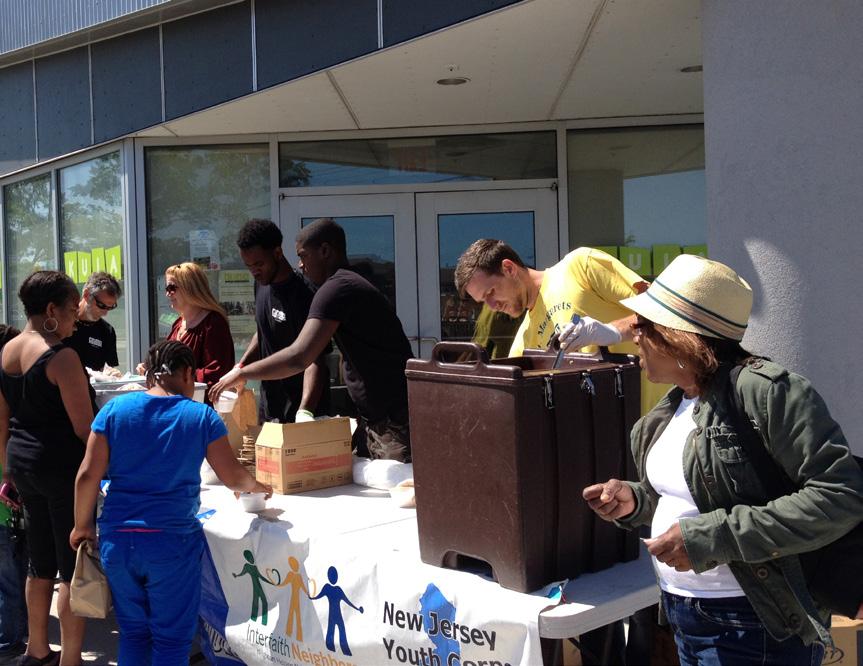

 All smiles.
Credit: Cerrone Photo
All smiles.
Credit: Cerrone Photo

Interfaith Neighbors will work closely with local, regional, and state organizations and agencies to implement this plan. Since the Choice planning process began over two years ago, various stakeholders have built crucial relationships and capacity in order to bring both plans to fruition. Together, these partners will collaborate on new and expanded programs, leverage public and private funds, and involve the community in the work of improving the West Side. Most importantly, these two plans represent the West Side residents’ vision, and many have become involved in improving the neighborhood and will continue to do so into implementation.
The matrix on the following pages outlines each strategy in terms of potential partners, potential funding sources, expected time frame, and estimated cost range. Cost ranges are expressed in orders of magnitude, on a scale from one (least costly) to four (most costly) dollar signs. Timeframes are described as short (0-2 years), medium (2-5 years), long (5-10 years), or ongoing (will be done continuously throughout the next 10 years).
Short: 0-2 years
Medium: 2-5 years
Long: 5-10 years
$

1. Through the newly launched SOAR Program, Interfaith Neighbors and its partners seek to tackle a host of job readiness and job search challenges that West Side residents face. It is an intensive, long-term employment and career preparation program that targets young adults and is designed to erase the stigma that employers associate with traditional job training programs.
City of Asbury Park; Community Affairs and Resource Center; Lunch Break, Inc.; Asbury Park Chamber of Commerce
WIOA Grants; CDBG funds; Opportunity Zone funds; private foundations; Friends of the Spring Lake 5 Foundation; private employers; IMPACT 100 Group; Mary Owen Borden Foundation medium
$$$ high
$
1. Work with local, regional and state entities to position West Side residents to qualify for leases and economic incentives that could support them in opening businesses within the neighborhood.
City of Asbury Park; for-profit developers; designated developer of West Lake in Neptune, NJ NJEDA; Monmouth County Economic Development Office; NRTC ongoing $$$ medium
2. Work with developers to create a diversity of retail spaces that are accessible to entrepreneurs just starting out as well as larger businesses that need more space.
Developers in Springwood Ave Gateway Zone and Neighborhood Commercial Zone Opportunity Zone funding ongoing $$ medium
3. Provide small business services such as consultation in marketing, advertising, tax prep, business model adaptation, and expansion.
Local SCORE chapter; Asbury Park-based branding consultants NRTC tax credit investments; SCORE contributions; PNC Bank; PNC Foundation short $ medium
4. Hire a corridor manager to provide assistance to businesses, bring resources to the corridor, oversee activities to make the corridor clean and safe, and work to attract new businesses to the area.
City of Asbury Park; Asbury Park Chamber of Commerce CDBG funds; UEZ funding; Opportunity Zone funding medium $$ medium
5. Encourage the development of restaurants and places to meet and gather along Springwood Avenue through outreach to potential retailers and marketing of existing municipal incentives.
City of Asbury Park; Asbury Park Chamber of Commerce CDBG funds medium $$ medium
6. Develop a neighborhood branding and marketing strategy tied to the City’s ongoing signage and wayfinding initiative.
City of Asbury Park; Asbury Park Chamber of Commerce CDBG funds; NRTC funds short $ medium
1. Construct the Parkview AP Residences, a planned homeownership development by Interfaith Neighbors. short $$$$ high
2. Expand the Pathway to Homeownership program, a rent-to-own program that enables families to work their way towards owning an affordable home. HOME Program; NRTC medium $$$ high
3. Expand the “Rights of Passage” program in partnership with Covenant House, which provides transitional housing for at-risk youth. Covenant House HOME Program short $$$ high
4. Expand rental assistance programs.
$
Community Affairs and Resource Center; Monmouth County Department of Social Services ongoing $$$ medium
5. Develop a comprehensive homeownership course that assists residents before, during and after the purchase of a home. Wells Fargo Bank; PNC Bank; M&T Bank; Affordable Housing Alliance medium $ medium
1. Continue to expand the City’s property and zoning code enforcement efforts.
City of Asbury Park ongoing $$ medium
2. Rehabilitate qualifying affordable single family homes in the West Side with RCA funds by re-branding the program, reaching out to qualifying homeowners, and leveraging related grassroots efforts.
City of Asbury Park; Coastal Habitat for Humanity RCA funds ongoing $$$ medium
3. Expand the newly launched Coastal Habitat for Humanity “Love Your Neighbor” block cleanup program.
Coastal Habitat for Humanity short $$ medium
5. Install commemorative trash and recycling bins for neighborhoods completing “Love Your Neighbor” program.
City of Asbury Park; Coastal Habitat for Humanity NRTC program medium $ low
5. Continue to expand and support Coastal Habitat for Humanity’s “Brush with Kindness” home improvement program.
Coastal Habitat for Humanity short $$ medium
4. Expand the use of municipal tools to manage and rehabilitate vacant and abandoned properties, including the New Jersey Abandoned Properties Rehabilitation Act.
City of Asbury Park; Housing and Community Development Network of NJ; Coastal Habitat for Humanity NRTC program ongoing $ medium $
1. Encourage more placemaking opportunities with community and youth support and participation, such as special events, block parties, designing gateways at key intersections, and new or expanded public spaces.
West Side Citizens United; faith-based community; Greater Asbury Park Community Development Initiative
NRTC; Chamber of Commerce ongoing $$ high
2. Create a heritage walk celebrating the history of the West Side.
Monmouth University; Asbury Park Historical Society; faith-based congregations; Asbury Park Library African American Musical Heritage Project
NRTC; Asbury Park Historical Society medium $$ low
3. Develop a campaign to add murals throughout the neighborhood that reflect and celebrate the past, present, and future of the West Side, utilizing local artists to the greatest extent possible.
Asbury Park Arts Council; Boys and Girls Club; Asbury Park Board of Education
Corporate sponsors medium $$ medium
4. Develop a community-driven cultural and economic opportunity center at a key location in the neighborhood.
African American Music Heritage Project; Asbury Park Arts Council; NJEDA
NRTC; Opportunity Zone funds; corporate foundations; private foundations medium $$$$ high
1. Expand healthy food choices in the neighborhood through expanded community gardens, a farmer’s market in Springwood Park, healthy foods at corner stores, and partnerships with local schools.
Kula Farm; West Side Citizens United; faith-based community; Greater Asbury Park Community Development Initiative; Community Food Bank of New Jersey
Robert Wood Johnson Foundation; Hackensack Meridian Health ongoing $$ high
2. Improve access to and opportunities for physical activity.
Monmouth University; Asbury Park Historical Society; faith-based congregations; Asbury Park Library African American Music Heritage Project
NRTC; Athletic equipment manufacturers; professional sports foundations medium $$ medium
3. Improve access to affordable health care and mental health services.
City of Asbury Park; Alliance for a Healthier Asbury Park; Asbury Park Complete Streets Coalition
Robert Wood Johnson Foundation; Hackensack Meridian Health ongoing $$$ high
4. Enhance the function and beauty of streetscapes for multi-modal use through new plantings, green stormwater infrastructure, and street trees.
City of Asbury Park; Environmental Shade Tree Commission long $$$ medium
5. Prioritize safe, comfortable, and attractive non-vehicular linkages to destinations and amenities throughout the West Side.
City of Asbury Park; Alliance for a Healthier Asbury Park; Asbury Park Complete Streets Coalition ongoing $$$ medium
6. Improve access to quality affordable housing for all residents. short $$$$ high
$ $
1. Expand outreach for existing literacy, GED and ESL programs available in the region.
Community Affairs and Resource Center; Brookdale Community College medium $ medium
2. Expand tutoring and enrichment programs for school-aged children and youth, including academic programming as well as extracurricular enrichment.
Big Brothers Big Sisters NRTC program short $$ medium
3. Reinvigorate and expand collaborative and mentoring programming involving youth and APPD police officers.
Asbury Park Police Department; faith-based community NRTC program long $ medium
4. Identify and implement programs for youth ages 14 and above seeking first time employment and/or workplace skills in order to both explore and generate interest in later career paths through mentorships, career days, and networking events.
Boys and Girls Club of Monmouth County; City of Asbury Park Friends of the Spring Lake 5 Foundation; NRTC Program; WIOA; Public and Private Foundations short $$$ high
5. Expand summer academic programming to bridge the gap in the school year and minimize the “summer slide.”
$ $ $
2nd Baptist Church; Boys and Girls Club of Monmouth County; Asbury Park Music Foundation ongoing $$ medium
1. Convene a coalition of local and regional service providers to exchange information and brainstorm how to keep each other informed of programs/ services on a regular basis.
City of Asbury Park short $ medium
2. Set up an electronic message board at a key intersection along Springwood Ave or at Springwood Park, updated regularly by the City communications department.
City of Asbury Park long $$ low
3. Create and continually update an online database and app containing information on available services and programs. medium $ medium
$
4. Distribute information through meaningful relationships and rapport with local faith-based organizations and social gathering spots. Faith-based organizations; West Side Citizens United; Asbury Park School District ongoing $ medium
 Tomatoes growing at Kula Urban Farm.
Credit: WRT
Tomatoes growing at Kula Urban Farm.
Credit: WRT

The WFRF West Side Neighborhood Plan Steering Committee was comprised of 17 community members, many of whom were also actively involved in the Choice Neighborhood planning initiative (for list of members see Acknowledgments page). The WFRF Steering Committee met on the following dates:
• January 16th, 2018
• February 27th, 2018
• March 22nd, 2018
• April 17th, 2018
• May 17th, 2018
Because of the strong concern that West Side residents have for the community’s youth in terms of safety and preparing for future success, a youth task force was formed to give young people a chance to contribute meaningfully to the plan. The Youth Committee met on the following dates:
• March 12th, 2018
• April 17th, 2018
• July 23rd, 2018
The task force’s contributions to the plan included specific ideas for after-school and enrichment programs that would be popular in the neighborhood, like cooking, theater, public speaking, events with the police department, and exercise classes.


Throughout late summer and early fall of 2017, Interfaith Neighbors ran a drawing contest for West Side youth. The prompt given was to draw their neighborhood, with the incentive of a prize for the community-chosen winners and for the works to be put on display in the Springwood Center building. Winners were honored at a ceremony at the Kula Cafe.
In an effort to spread the word about the plan and get feedback from as many residents as possible, Interfaith Neighbors had a constant presence at the weekly Music in the Park series every Monday evening during summer 2017. Each week, a different “fill in the blank” question was posed for residents to answer as they enjoyed the concert.


A coalition of organizations came together to put on the “Super Safe Summer” festival and summer resource fair on June 2, 2018. Alongside food and games, a number of organizations that provide services to youth in the community were present to spread information and sign young people up for fun, productive programming for the summer ahead. Interfaith Neighbors participated and spoke to festival goers about the variety of programs they offer to teens, including the Kula Cafe worker training program, in addition to other services that benefit families in the West Side.
Launched in summer 2018 partly with seed funding from the Choice Plan Early Action Activities budget, the Love Your Neighbor program is a critical expansion of grassroots home improvement efforts in the neighborhood. Coastal Habitat for Humanity runs the program in coordination with its partners, including Interfaith Neighbors.


On Saturday, July 7th, 2018, Interfaith Neighbors conducted a short survey at Midtown Commons Park in neighboring Neptune, NJ. The survey focused on the most common ways that residents communicate with each other and how they most often receive information about their community. The survey template can be seen on the following page. A total of 43 people were surveyed. The results reflected what other data and surveys have shown, which is that people primarily communicate and find information via informal networks like texts, churches, and word of mouth. See table for results.

Interfaith Neighbors has embarked on three resident survey efforts in the past 10 years, made possible by grants from the Wells Fargo Regional Foundation. Surveys were administered in 2008, 2012, and 2016. Residents were asked a series of questions about neighborhood satisfaction, quality of life, homeownership, and their sense of community. Though not all the exact same questions were asked all three times, it is still possible to derive some trends from the data about how residents feel about their neighborhood and where they think it is headed. What follows is an analysis of the 2016 survey findings in relation to comparable data from 2008 and 2012.
Interfaith Neighbors, Asbury Park, NJ
2008, 2012, & 2016 Survey Analysis
Report prepared by:
Alys Mann
Alys Mann Consulting
February, 2017
Over the past eight years, residents of the West Side Neighborhood have been surveyed three times: once in 2008, once in 2012, and again in 2016. Residents were asked a series of questions about resident satisfaction, sense of community, quality of life aspects, neighborhood change, and prospective homebuyers.
This report looks specifically at the 2016 survey findings and how they compare with the findings from 2012. For some questions we review the trends from 2008, 2012, and 2016.
In 2016, Interfaith Neighbors used a systematic random sampling approach, obtaining 244 completed surveys They used trained surveyors to conduct the survey as a one-on-one interview with an adult member of the household. The answers to the surveys are compared to measure change in resident perception between 2008, 2012 and 2016 and general trends within the neighborhood.
The analysis is organized under five different subsections including information on Resident Satisfaction, Sense of Community, Tenure and Perspective Homebuyers, Quality of Life, and Neighborhood Change. The results are displayed in a combination of graphs and statistical tests that show change in the neighborhood over time.
For additional information on t-test calculations and open ended response analysis, please refer to Appendix A.
Overall, the neighborhood has seen significant improvements in resident satisfaction and quality of life ratings between 2012 and 2016. While there is still work to do, residents feel the neighborhood is improving.
Resident Satisfaction:
In 2016 the majority of respondents say they would recommend the neighborhood as a good place to live, an eighteen percentage point increase since 2012. Respondents also report they are somewhat satisfied living in the community in 2016 compared with 2012 when respondents reported they were somewhat dissatisfied living in the community. Respondents say they live in the neighborhood to be near family and friends. In 2016 just under half of respondents say they would continue to live in the community if given a choice, up from one-third of respondents in 2012.
Between 2008, 2012, and 2016, the percentage of respondents that do not speak with any neighbors declined and those that speak with seven or more increased. Respondents are split over whether they feel neighbors would work together to fix problems in the neighborhood, though slightly more “agree” with the statement than “disagree.” In both 2012 and 2016 respondents, on average, feel it is somewhat likely for neighbors help each other out.
In 2016, 74% of respondents were renters and 19% owned their home. An additional 7% said they neither own nor rent their home. In 2016, 38% of renters said they were interested in purchasing a home in the neighborhood, up from only 20% in 2012. The primary reason renters want to purchase a home, but haven’t done so yet is due to their personal financial situation. Of the renters that say they do not wish to purchase a home, the primary reasons split evenly between crime and safety issues in the neighborhood as well as their personal financial situation.
Between 2012 and 2016 there has been an improvement in how respondents rate each of ten different quality of life aspects. In 2016, access to transportation rated highest. Respondents felt things like access to employment centers, the variety of goods and services available for purchase, and the quality of public services rated fair to good. Cleanliness in the community, and the condition of streets, sidewalks, parks, and homes rated fair. Safety in the community was rated among the lowest in 2016, however safety in the community also improved the most since 2012.
In 2016 more than half of respondents say the neighborhood has improved over the last three years. About the same percentage of respondents say the neighborhood will continue to improve over the next three years.
Interfaith Neighbors
Right now how likely are you to recommend the neighborhood as a good place to live to someone, to families with children, or to seniors?
One measure of resident satisfaction is that neighbors would recommend the neighborhood to other people as a good place to live. In 2016, more than half of survey respondents say they would “definitely recommend” or “probably recommend” the West Side Neighborhood to someone as a good place to live. Just under half of respondents would recommend the neighborhood to families with children or to seniors. This is a substantial increase since 2012 when only 36% of respondents said they would recommend the neighborhood as a good place to live, 27% said they would recommend the neighborhood to families with children and 26% said they would recommend the neighborhood to seniors.

In order to measure if the increase in respondents that would recommend the neighborhood is statistically significant, a recommendation score was developed for each recommendation question and a number was assigned for each answer category. For example, the answer “Definitely would not recommend” was assigned a 1, “Probably would not recommend” was assigned a 2, “Probably would recommend” was assigned a 3, and “Definitely would recommend” was assigned a 4. A mean score was then calculated for each question. Mean scores above a 2.5 indicate respondents are generally more likely to recommend the neighborhood, and if the mean score is below 2.5, respondents are generally less likely to recommend the neighborhood, on average.
Between 2012 and 2016 respondents are more likely to recommend the neighborhood to someone, to families with children and to seniors as a good place to live. These changes are statistically significant.
Recommend Neighborhood to Seniors 1.82 2.25 UP ***
Note: *** indicates difference is statistically significant at p<0.01; ** indicates difference is statistically significant at p<0.05; * indicates difference is statistically significant at p<0.1
Overall, considering everything, how satisfied would you say you are living in this community?
Overall satisfaction in the community has improved between 2012 and 2016. In 2016 about 31% of respondents say they are either “satisfied” or “very satisfied” living in the neighborhood, compared with 21% in 2012. There is still a sizable portion of respondents that say they are not satisfied. In 2016, 24% say they are either “dissatisfied” or “very dissatisfied,” but this has decreased from 36% that were dissatisfied in 2012.
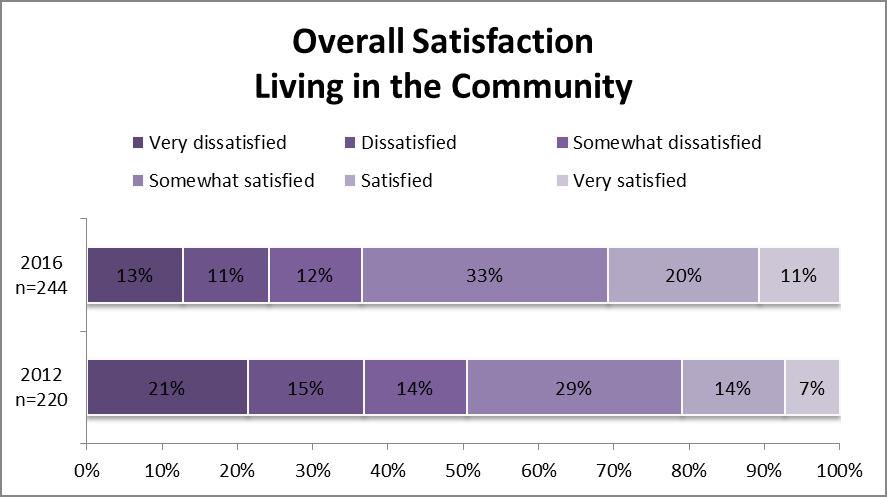
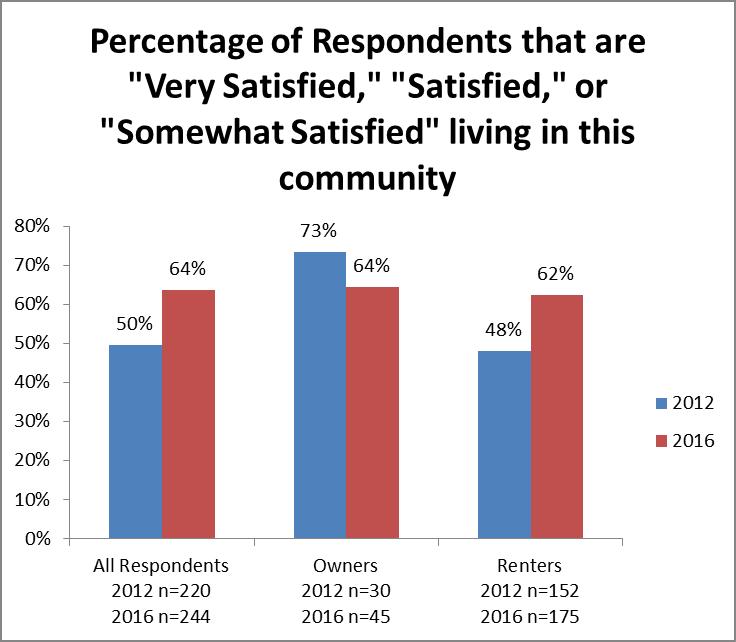
Looking at overall satisfaction by tenure, there is little variation in 2016 between satisfaction levels of owners and renters. Overall satisfaction for renters has improved between 2012 and 2016 going from 48% of renters feeling they were at least somewhat satisfied to 62% feeling they were at least somewhat satisfied. Satisfaction
Interfaith Neighbors Survey
To measure whether the change in satisfaction is statistically significant, we create a satisfaction score. The satisfaction score was created by assigning each answer to the question “Overall, considering everything, how satisfied are you living in this neighborhood” a numeric number. The answer “Very dissatisfied” was assigned 1, “Dissatisfied” was assigned 2, “Somewhat dissatisfied” was assigned 3, “Somewhat satisfied” was assigned 4, “Satisfied” was assigned 5, and “Very satisfied” was assigned 6. Each answer was averaged together to create a mean score by year and by tenure. A score over 3.5 would indicate that respondents, on average feel more satisfied than dissatisfied and a score of 3.5 or less would indicate that respondents felt more dissatisfied than satisfied.
Overall satisfaction increased between 2012 and 2016, going from an average score of 3.2, slightly more dissatisfied than satisfied, to an average score of 3.68, indicating respondents are more satisfied than dissatisfied. Overall satisfaction also increased for renters, but did not change for homeowners.
Satisfaction Score
2012 2016 Direction Statistical significance
Mean Satisfaction Score 3.20 3.68 UP ***
Mean Satisfaction Score for Owners 3.93 3.71 unchanged
Mean Satisfaction Score for Renters 3.15 3.64 UP ***
Note: *** indicates difference is statistically significant at p<0.01; ** indicates difference is statistically significant at p<0.05; * indicates difference is statistically significant at p<0.1
Which of these is the major reason you decided to live in this community?
In both 2012 and 2016 we asked respondents about the top reason they decided to live in the neighborhood. In both 2012 and 2016 one of the top answers was to live near family and friends.


Interfaith Neighbors
If you had the choice, would you continue to live in this community?
Given the choice, almost half of respondents in 2016 say they would continue to live in the neighborhood. This is up from only 35% in 2012. The change is statistically significant.

Comparison of Means - Continue to live in the neighborhood
2012 2016 Direction Statistical Significance Continue to Live in the Neighborhood if you had the choice 0.35 0.49 UP ***
Note: *** indicates difference is statistically significant at p<0.01; ** indicates difference is statistically significant at p<0.05; * indicates difference is statistically significant at p<0.1
Interfaith Neighbors
Survey Analysis 2008, 2012, & 2016
Page 7 of 21
With how many of your neighbors do you speak regularly for five minutes or more?
Between 2008 and 2016, there has been a decline in respondents that say they speak with none of their neighbors and an increase in respondents that speak with seven or more of their neighbors regularly. In 2016, about one-third of respondents speak with seven or more neighbors regularly and 88% speak with at least one neighbor regularly.

Please indicate your level of agreement: If something is wrong in my neighborhood, I know that the people who live here will try to fix it.
One way to measure the sense of community is to ask if residents feel that people in the neighborhood would work together if something was wrong. In 2016, about 39% of respondents “agree” or “strongly agree” neighbors would work together while 32% either “disagree” or “strongly disagree.” Between 2012 and 2016 there has not been any significant change to how respondents answer this question.

2012 2016 Direction Statistical Significance
If something were wrong in this community neighbors would work together to fix it
2.87 3.02 unchanged Not statistically significant Note: *** indicates difference is statistically significant at p<0.01; ** indicates difference is statistically significant at p<0.05; * indicates difference is statistically significant at p<0.1
I’d like you to consider a number of situations that might occur and tell me how you think people would respond. How likely do you think it is that people in this community would help out if you needed a ride somewhere, if a package was delivered when you were not at home and it needed to be accepted, if you needed a favor, such as picking up mail or borrowing a tool, if you needed someone to watch your home when you were away, if an elderly neighbor needed someone to periodically check on him or her, if a neighbor needed a someone to take care of a child in an emergency? Would you say it is very likely, likely, somewhat likely, not very likely, or not at all likely?
We ask respondents how likely they think neighbors would help each other out as a way to measure neighborliness or social cohesion in the community. In 2016, roughly half of respondents feel it is “likely” or “very likely” neighbors would help each other out when asked about six different situations. More respondents (55%) tended to feel it is likely that someone would check on an elderly neighbor while fewer respondents (43%) felt someone is likely help out if you needed a ride somewhere.

Interfaith Neighbors
Survey Analysis 2008, 2012, & 2016 Page 9 of 21
Using the series of questions on the likelihood a situation would happen, a social connectedness score is created to measure how socially connected the community is. The scores are then compared in both 2012 and 2016 to see how the scores changed and if the change is statistically significant.
The scores are developed based on how each respondent answered the series of six likelihood questions. The answer categories for each of the six questions are assigned a number. If a respondent says something is “very likely” to occur a score of 5 is attributed to the answer, if something is “likely” to occur, a score of 4 is attributed to the answer, if something is “somewhat likely” to occur, a score of 3 is attributed to the answer, if something is “not very likely” a score of 2 is attributed to the answer and if something is “not at all likely” a score of 1 is attributed to the answer. The scores for then added together for each of the six questions and a social connectedness score is created. A score of 6 is the lowest possible score indicating the respondent felt neighbors were not at all likely to help in a number of situations and that there is extremely low social connection in the community. A score of 30 is the highest possible score indicating the respondent felt neighbors were very likely to assist in a number of situations and that there is extremely high social connection in the community. A mean social connectedness score is then calculated for each year.
On average, respondents in both 2012 and 2016 are “somewhat likely” to help neighbors out. While the mean score increased slightly from 2012 to 2016, the change is not statistically significant.
Social Cohesion Score
2012 18.69
2016 19.19
*Change is not statistically significant
What are the things you like best about living in the neighborhood? You can choose up to three things.
In 2016 respondents say the things they like best about living in the neighborhood include their home or apartment, proximity to work, the affordability of housing, and the proximity to public transportation.

What are the things you like least about living in the neighborhood? You can choose up to three.
In 2016 the things respondents like least about the neighborhood include safety in the community, schools for the children, and their neighbors. Between 2012 and 2016 the percentage of respondents that felt they liked safety in the community least decreased from 62% to 40%.

Of those that selected “other,” about 32% referenced crime, drugs, or safety concerns in their answer.
Interfaith Neighbors
Survey Analysis 2008, 2012, & 2016 Page 11 of 21
Do you currently rent your home or do you own it?
In 2016, 74% of respondents are renters while 19% are home owners. An additional 7% say they neither rent or own their home.

If you do not currently own, would you consider purchasing a home in the neighborhood?
In 2016, 38% of respondents that do not own their home say they would like to purchase in the neighborhood, up from only 20% in 2012. This increase is statistically significant.

Comparison of Means - Would you buy a home in this community (renters only) 2012 2016
Mean n= Mean n= Direction Statistical Significance
Would buy 0.20 182 0.38 168 UP ***
Note: *** indicates difference is statistically significant at p<0.01; ** indicates difference is statistically significant at p<0.05; * indicates difference is statistically significant at p<0.1
Interfaith Neighbors
Survey Analysis 2008, 2012, & 2016 Page 12 of 21
Of the renters that say they would like to purchase a home, but haven’t done so yet, the primary reason is: (n=59)
• 66% say it is due to their personal financial situation
• 8% say it is due to crime or other safety issues
Of the renters that say they are not interested in purchasing a home in the neighborhood, the primary reason is: (n=106)
• 35% say it is due to crime or other safety issues
• 33% say it is due to their personal financial situation
Interfaith Neighbors
Survey Analysis 2008, 2012, & 2016 Page 13 of 21
In both 2012 and 2016, respondents were asked to rate a number of things related to quality of life in the neighborhood. A mean score was then developed for each quality of life aspect. Each answer category was assigned a number where “very good” was assigned a 5, “good” was assigned a 4, “fair” was assigned a 3, “poor” was assigned a 2 and “very poor” was assigned a 1. Once the mean score was calculated we conducted statistical significance testing to compare the changes in ratings between 2012 and 2016.
In 2016 the highest rated quality of life aspect was access to transportation with 68% of respondents rating it as “good” or “very good.” Between 42% and 46% of respondents rated things that the neighborhood offers, such as access to employment centers, the variety of goods and services available for purchase, and the quality of public services as “good” or “very good.” Aspects such as physical infrastructure, cleanliness in the community, and the quality of homes were rated among the lowest in 2016. Safety in the community appears to still be a major concern. Only 19% of respondents rated safety as “good” or “very good” in the community.
Every quality of life aspect rated in the neighborhood has improved since 2012. Despite safety being rated among the lowest quality of life aspects in 2016, safety ratings improved the most between 2012 and 2016, going from 1.8 (between poor and very poor) to 2.45 (between poor and fair). Access to employment centers showed a sharp improvement as well, going from 2.82 (between poor and fair) to 3.32 (between fair and good).

Note: *** indicates difference is statistically significant at p<0.01; ** indicates difference is statistically significant at p<0.05; * indicates difference is statistically significant at p<0.1
Compared to three years ago, how would you say this neighborhood has changed overall?
In 2016, 56% of respondents felt the neighborhood has “improved some” or “improved a lot” over the past three years. This is up from only 28% of respondents that felt the neighborhood improved over the past three years in 2012. There is no variation between owners and renters.


Thinking about the next three years, how would you say this neighborhood is likely to change?
The majority of respondents in 2016 are optimistic the neighborhood will “improve a lot” or “improve some” over the next three years. Respondents are more optimistic about the future of the neighborhood in 2016 compared with 2012.
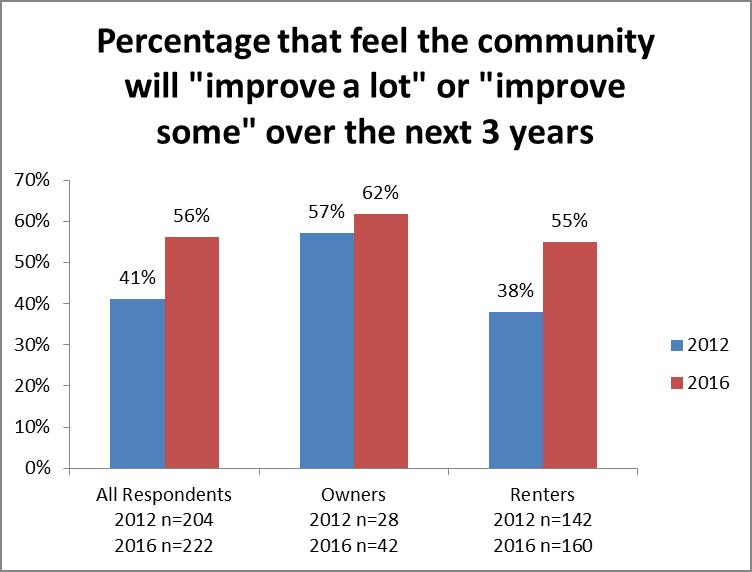

The recommendation score is developed by assigning a numerical value to each response to the question “Would you recommend the neighborhood as a good place to live?” “Would you recommend the neighborhood to families with children as a good place to live?” and “Would you recommend the neighborhood to seniors as a good place to live?” Each response is assigned a numerical value on a four point scale where 1 point is assigned to responses of “Definitely would not recommend,” 2 points are assigned to responses of “Probably would not recommend,” 3 points are assigned to responses of “Probably would recommend,” and 4 points are assigned to responses of “Definitely would recommend.” A neighborhood with an average score of 2.5 would result from responses that were evenly split across all answer categories – in other words, respondents, on average, see the neighborhood in a neutral light and would be evenly split between those that would recommend the neighborhood and those that would not recommend the neighborhood. A score below 2.5 would show that on average, respondents see the neighborhood in a negative light, and do not recommend the neighborhood and a score above 2.5 would show that, on average, respondents see the neighborhood in a positive light and would recommend the neighborhood. A T-test was then performed to assess whether the changes in the mean scores from 2012 and 2016 are statistically significant.
The satisfaction score is developed by assigning a numerical value to each response to the question “Overall, considering everything, how satisfied would you say you are living in this community?” Each response is assigned a numerical value on a six point scale where 1 point is assigned to responses of “Very dissatisfied,” 2 points are assigned to responses of “Dissatisfied,” 3 points are assigned to responses of “Somewhat dissatisfied,” 4 points are assigned to responses of “Somewhat satisfied,” 5 points are assigned to responses of “Satisfied,” and 6 points are assigned to responses of “Very satisfied.” A neighborhood with an average score of 3.5 would result from responses that were evenly split across all answer categories where responses are overall neither satisfied or dissatisfied living in the neighborhood. A score below 3.5 would show that on average, respondents are dissatisfied living in the community, while a score above 3.5 would show that, on average, respondents are satisfied living in the community. A T-test was then performed to assess whether the changes in the mean scores from 2012 and 2016 are statistically significant.
The mean comparison score for the question “If you had the choice, would you continue to live in this community?” is calculated by assigning a numeric value to the respondents answer where if the respondent answered “yes” a score of 1 is assigned and if the respondent answered “no” a score of 0 is assigned. The scores are then averaged together and a t-test was conducted to see if the difference in scores between 2012 and 2016 is statistically significant.
The mean score of the question “If something is wrong in my neighborhood, I know that the people who live here will try to fix it” is calculated by assigning a numerical value on a five point scale to each response where “strongly disagree” is assigned a 1, “disagree” is assigned a 2, “neither agree or disagree” is assigned a 3, “agree” is assigned a 4, and “strongly agree” is assigned a 5.
The scores are then averaged together to obtain a mean score. A neighborhood with an average score of 3.00 would result from responses that were evenly split across all answer categories, a score below 3.00 would show that on average, respondents think negatively about the question and a score above 3.00 would show that on average, respondents think positively about the question.
The social connectedness score is developed by assigning a numerical value to each response to a series of questions and then adding the numerical values together to create a social connectedness score. The series of questions ask respondents about the likelihood neighbors would help each other out in a variety of different situations. The series of questions include, “how likely do you think it is that people in this community would help out if you needed a ride,” “if a package was delivered when you were not at home and it needed to be accepted,” “if you needed a favor, such as picking up mail or borrowing a tool,” “if you needed someone to watch your home when you were away,” “if an elderly neighbor needed someone to periodically check on him or her,” and “if a neighbor needed someone to take care of a child in an emergency.” The answer categories are based on a five point scale where if a respondent says something is “very likely” to occur a score of 5 is assigned to the answer, if something is “likely” to occur a score of 4 is assigned to the answer, if something is “somewhat likely” to occur a score of 3 is assigned the answer, if something is “not very likely” a score of 2 is assigned to the answer and if something is “not at all likely” a score of 1 is assigned to the answer.
The scores are then added together for each of the six questions and a social connectedness score is created. A score of 6 is the lowest possible score indicating the respondent felt neighbors were not at all likely to help in a number of situations and that there is extremely low social connection in the community. A score of 30 is the highest possible score indicating the respondent felt neighbors were very likely to assist in a number of situations and that there is extremely high social connection in the community. The overall social connectedness score is developed by taking the mean social connectedness score. A t-test is conducted to assess whether the difference in scores between 2012 and 2016 are statistically significant.
Would you purchase a home in the neighborhood?
The mean comparison score for the question “would you buy a home in this neighborhood” is calculated by assigning a numeric value to the respondents answer where if the respondent answered “yes” a score of 1 is assigned and if the respondent answered “no” a score of 0 is assigned. The scores are then averaged together and a t-test was conducted to see if the difference in scores between 2012 and 2016 is statistically significant.
Quality of life scores were calculated for each respondent by assigning a numerical value to the rating of a series of quality of life aspects in the neighborhood. A rating of “very poor” received a score of 1 point, a rating of “poor” received a score of 2 points, a rating of “fair” received a score of 3 points, a rating of “good” received score of 4 points, and a rating of “very good” received a score of 5 points. The mean of all the respondents ratings were then calculated for each statement. A mean score of 3 indicates that respondents, on average, rate the aspect as fair. A mean score lower than 3 indicates that on average respondents rate the aspect as poor and a mean score higher than 3 indicates that on average respondents rate the aspect as good. A t-test is conducted to compare the average scores between 2012 and 2016.
Interfaith Neighbors
Survey Analysis 2008, 2012, & 2016
Page 21 of 21
